
WINTER 2022/2023 COMPLIMENTARY COPY


WINTER TRAILS THE HOUSING PROBLEM SKIING WITH DOGS




















WINTER 2022/2023 COMPLIMENTARY COPY






















283 North First East St. Driggs, ID 83422 83 North Main St. Victor, ID 83455



































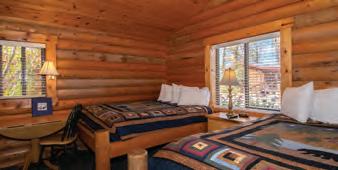



This winter edition marks the twenty-fifth anniversary of Teton Valley Magazine—wow! Celebrating such a milestone invites a bit of welcomed reflection. Maybe you remember the first time you found yourself or a loved one in the pages of our award-winning magazine. Or recall when you first read a story that has stayed with you to this day. One of the parts of this magazine that remains special to me is its ability to archive a moment in time in our valley. Each issue is a snapshot of life in Teton Basin—the people doing exceptional things, the fun to be had just out our back door, and the themes shaping the Teton Valley experience, as told and captured by our talented writers and photographers.
Inside this issue, you’ll find Christina Shepherd McGuire’s history of the Teton Valley Ski Education Foundation and the amazing kids that have come up through the ranks, like Olympian Jaelin Kauf (page 58). Learn to safely adventure with your pup, while also deciding when it’s best to leave Fido home (page 74). And, if you’re new here, welcome! Enjoy editor at large Michael McCoy’s tips and advice in Welcome Teton Valley Newcomer (page 52). I think you’ll agree, this edition is filled with a diverse crop of fantastic stories.
This anniversary issue also offers a glimpse into a particularly challenging and transitional time. There’s exciting growth— we can’t wait to ride the Colter Lift at Grand Targhee Resort and are thrilled to see Pierre’s Theatre embark on its second act, both spotlighted in our pages—along with some uncertainty as we wade through murky waters during a housing crisis. While perusing the TVM archives, I came across a piece published in 2012 about the renewed vibrancy hitting Main Street in Driggs as businesses filled once-vacant shops. Writer Rob Marin reveled in the welcomed change after years of empty storefronts. Just over a decade later, accelerated growth of a different color demands a new type of consideration. In this issue, writer Tom Hallberg, in his feature Building for a Better Future (page 64), spotlights the faces behind the housing crisis and what is being done to stem it. Can we sustain this community’s character amid mushrooming housing costs without pricing out our residents? Thanks to our city and county staff working to do so, hope is on the horizon.
As I reflect on all we’ve covered, it is nearly impossible to sum up twenty-five years of remarkable storytelling. From efforts to preserve the wild landscape and deep dives into the snowpack, to delicious restaurants, hardworking farmers, and historical wonders, you’d think by now we would have covered it all. As I look at my chicken-scratch list of story ideas, I can tell you with certainty we are just getting started.







publisher + editor in chief
Kate Hull kate@powdermountainpress.com
publisher + art director
Sage Hibberd sage@powdermountainpress.com
sales manager
Jessica Pozzi
jessica@powdermountainpress.com
publisher emeritus
Nancy McCullough-McCoy
editor at large
Michael McCoy
design advisor

Linda Grimm
graphic designer
Dave Stein
contributors
Molly Absolon
Lara Agnew
Judy Allen
Jeanne Anderson
Ryan Ariano
Natalie Behring
Jeannette Boner
Camrin Dengel
P.M. Fadden
Mark Gocke



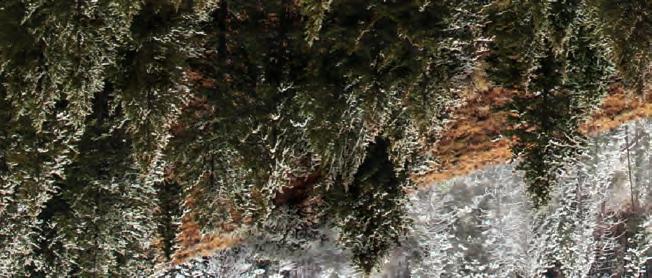

Tom Hallberg
Victoria Hollingsworth
Michael McCoy
Alex Nabaum
Christina Shepherd McGuire
Kristen Pope
Stacy Stamm
David Stubbs

Generational Wyoming & Montana Natives serving the Rocky Mountain West for over 50 years.


At just over 3,000 acres that rise 600 to 1200 feet above the Valley floor, High Range Ranches offer breathtaking, panoramic views. Located on Packsaddle Bench and bordering millions of acres of National Forest, High Range Ranches is just minutes from the charming community of Driggs, ID. This iconic property is a short drive to the Teton River (a Blue-Ribbon fishery), Tributary Golf Resort, Reed Memorial Airport and Grand Targhee Ski Resort. www.highrangeranches.com
100 to 376 acre ranch sites starting at $2,500,000

Homesteaded in the late 1,800’s, CK Ranch still carries the last two letters of the founding families last name; Linback. Located on the banks of North Cottonwood Creek, CK Ranch borders nearly 5 miles of forest service and holds a similar length of fishing stream that has historically maintained its designation as a premier Blue Ribbon Fishery. A very rare find, in the middle of northwest Wyoming, 1.5 hours from Jackson Hole, and 3.5 hours from Salt Lake City. www.ckranchwy.com
Price | $19,995,000
Camrin Dengel
Camrin (Dog Days of Winter, page 74) is a Teton Valley-based editorial and commercial photographer. Her work tells honest stories, often exploring themes of food and farms, working with our hands, and outdoor lifestyles. She enjoys being out in the mountains, sipping a good cup of coffee, and spending time with her dog.


A devoted husband and father, an avid skier and friend, P.M. Fadden (Recreation with Roots, page 40) contributes works of fiction and nonfiction to magazines and newspapers around the world. Prior fieldwork took him to the Japan Alps and Argentine Patagonia. Excerpts from his catalog can be found in Bomb Snow, Alaskan Spirit, Adventure Magazine NZ, and BigLife. P.M. values fresh perspective, bold artistry, and the chocolate chip cookie.

Michael McCoy (Dear Teton Valley Newcomer, page 52) began wordsmithing on both sides of the Tetons in 2005, when he signed on as editor of Teton Valley Magazine after his wife Nancy purchased Powder Mountain Press. (He’d been editing Jackson Hole Magazine since 1999.) He continued in that role through 2017, and still keeps his name in the game—and on the masthead—as our editor at large. Mac has also freelanced for numerous publications, including Men’s Journal, Runner’s World, and the National Geographic Book Division. He is currently working on Secret of the Winds, the sequel to his debut novel Sleeping Dogs Don’t Lie


As the managing editor of Backcountry Magazine, Tom Hallberg (Building for a Better Future, page 64) spends much of his time going backcountry skiing and splitboarding or writing about other people’s adventures in the mountains. When he writes about the people and places of Teton Valley and the surrounding region, he likes to highlight stories of resilience and transformation.
One moment Christina’s boots are covered in chicken poop and the next she’s playing taxi driver for soccer practice; while somewhere in between she’s striving for her version of “balance.” As the managing editor of Teton Family Magazine and Grand Wedding magazine, Christina (Snow as My Copilot, page 58) aims to help women and families live a slower, healthier, and more fulfilling lifestyle. To her, this often means hitting the trails in the high country or taking a mid-day siesta on her front porch in Tetonia.

Cover artist Alex Nabaum grew up in Colorado and Utah, but currently skis in Wydaho. He has worked as a treadmill tester, caricature artist, T-shirt designer, newspaper artist, and, for the last eighteen years, as a freelance illustrator. His illustrations have appeared in the pages of the Wall Street Journal, New York Times, National Geographic, Backcountry Magazine, and on the covers of Newsweek, Forbes, and ESPN. His favorite subject to illustrate is skiing (see skiposters.art).




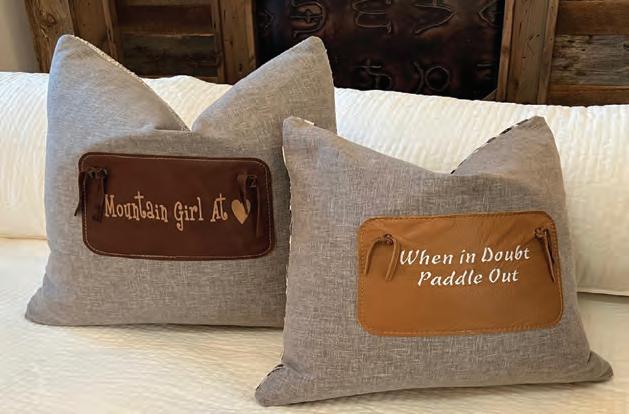











ENJOY a hearty brunch at Butter, or try sister restaurant Wanderlust Bistro, both in Victor
WARM UP with a latte before heading to the resort with a stop at French Press Coffee House
KICK OFF AN EPIC powder day with a ride up Peaked Mountain on Grand Targhee’s new Colter Lift
TAKE TO THE SNOW on two wheels! Rent a fat bike at Habitat and explore the valley’s groomed trails
EXPLORE THE TETON OUTBACK on skis with the professional and savvy guides at Yöstmark Backcountry Tours
ADVENTURE by snowmobile with Teton Valley Adventures (more on page 40)
REFUEL WITH A SMOOTHIE or freshly squeezed juice at the Barrels & Bins Smoothie Bar
SEARCH OPEN WATERS for snow-white trumpeter swans (but keep your distance, please)
STOCK UP FOR THE SEASON with produce and more from Teton Valley Online Farmers Market (page 102)
SAVOR A SLOW MORNING with an espresso and good company at Rise Coffee House in Driggs









VISIT VICTOR’S MAKERS DISTRICT for locally made goods from Give’r Gloves, New West KnifeWorks, and more
IMPROVE YOUR SKILLS ON SKINNY SKIS by booking a lesson with Teton Nordic Ski School
TAKE IN THE TALENT on display at the galleries dotting the valley, like Foxtrot Fine Art in Driggs
MUNCH ON FAJITAS and sip a wine margarita at Mexican food favorite Agave on Main Street in Driggs
DELVE INTO THE CHARACTER of the valley at the Teton Geo Center in Driggs
CHECK OFF YOUR LIST for gifts and more at Victor Emporium or Driggs’ Fireweed Shop & Studios
TAKE A DAY TRIP TO ISLAND PARK and explore Harriman State Park’s twenty-four miles of Nordic trails
HEAD OVER TETON PASS to the National Elk Refuge for a sleigh ride you won’t soon forget
SAVE THE DATE for Downtown Driggs Association’s stellar snow sculpting festivities in January
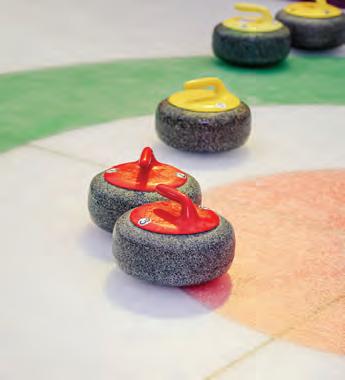

11 12 13 14 15 16 17 18 19 20 21 22 23 24 25 26 27 28 29 30
SHOP FOR GARDENING SUPPLIES, florals, gifts, and more at MD Nursery located just south of Driggs
CHANNEL YOUR INNER OLYMPIAN with a curling clinic at Kotler Ice Arena in Victor
KICK OFF HAPPY HOUR with an ice cold brew at Victor’s new hotspot, Refuge Taphouse, on Main Street
SIP A SAMPLE at Victor’s craft cidery, Highpoint Cider, then stick around for bingo or trivia night
ENJOY A CUSTOM DINING experience in your home or vacation rental with Tiny Town Culinary
CATCH LAST CHAIR at Grand Targhee then nosh on the famous Wydaho nachos at the Trap Bar and Grill
SAVOR delicious Italian fare and fresh handmade pasta at Pizzeria Alpino in Driggs
KICK BACK UNDER LAP BLANKETS on a Linn Canyon Ranch sleigh ride before enjoying a gourmet dinner
OPT FOR PIZZA NIGHT from any of the top-notch spots for a slice found in Victor, Driggs, and Tetonia
TOAST THE DAY’S ADVENTURES with a local pour and delicious meal at Citizen 33 in Driggs
CATCH A MUST-SEE PLAY, special event, or movie night with a twist at Victor’s historic Pierre’s Theatre


Pierre’s Theatre is embarking on the next act of its more than seventy-year tenure providing entertainment and culture to Teton Valley. Now, philanthropist and patron of the arts Anne Fish is at the helm, armed with a mission of creating a joyful gathering spot with art at its core. And if the offerings todate are any indicator, she’s doing just that and more.
An Austin, Texas, native, Anne—who is also a real estate advisor for Engel & Völkers Jackson Hole—grew up with a deeply rooted a ppreciation for the arts. She is a trained dancer and played several musical instruments growing up, her grandmothers were both pianists, and her parents were passionate supporters of the Austin Symphony Orchestra, to name just a few ties.
After a ttending college at the University of Wyoming, Anne made her way to Jackson Hole in 2001 where she dove into the real estate world. She and her husband, Jim Wunsch, made the move to the Idaho side five years ago. “I just love this valley’s family friendly atmosphere and the great people here,” she says. “That’s what makes it so special; people who just enjoy life.”
The path to giving new life to the shuttered theatre was perfect timing meets happen-
stance. In late 2020, rumors spread that the theatre’s days as such were over.
“I was looking at the real estate market ‘hot sheet’ as I do every morning, and I saw Pierre’s [had come] back on the market,” Anne says. “I thought, ‘Oh my gosh! This is my opportunity.’ Did I ever dream I would own a theater? Heck no.” But music and arts are so interwoven into her life, that it just made sense. In September 2021, Anne purchased the theatre with hopes of expanding the offerings beyond typical movies (but those are still happening, too!) and the occasional play by providing an outlet for even more events to take the stage.
From Friday night movies with a twist like “Mom’s Night Out” and Teton Gravity Research film premieres to welcoming worldreno wned musicians to the intimate stage, Pierre’s is filling the calendar with top-tier entertainment and opportunities to gather. It’s becoming the cultural heart of Victor.
In September, violin virtuoso Elizabeth Pitcairn dazzled the audience with an evening playing the legendary Red Violin. And this winter, don’t miss favorites like “A Christmas Carol,” hosted by Pierre’s and produced by the Arts, Cinema, and Theater (ACT) Foundation, and stay tuned for mustsee events to come. pierrestheatre.com
KATE BAYNE IS BRINGING her baked goods to your door, one fermented loaf or batch of cookies at a time, as part of her new baked goods deliver y business Sourdough Stuff. Her specialty? The name says it all.
A centuries-old baking practice, sourdough ferments the flour and creates probiotics, a process that causes the dough to rise na turally. “I love sourdough for its rich flavor and the benefits that come along with fermented dough,” Kate says. “Incorporating sourdough into my baking has allowed me to enjoy baked goods and still feel good.”
The idea is simple: At the start of the week, orders are placed at Kate’s website (one sourdough loaf is $9 and there is no minimum to buy) and on Thursday afternoon, the warm, freshly baked goodness is dropped off a t your doorstep. Sourdough fans can also try Kate’s perfectly gooey sourdough chocola te chip cookies. This winter, look for weekly specials like sourdough bagels and cinnamon rolls. Order online a t: sourdoughstuff.com.







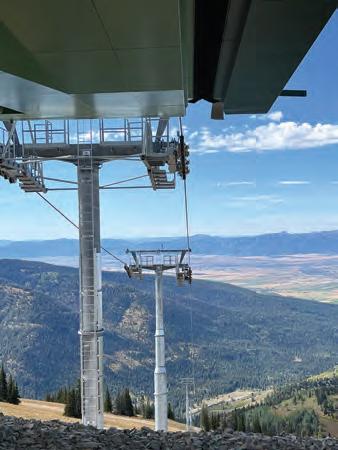

THE POWDER DAYS at the ‘Ghee just got a little bit more epic. Grand Targhee Resort kicked off the winter season with a brand-new lift that opens six hundred acres to skiers and riders. The Colter Lift on Peaked Mountain will transport up to two thousand people per hour, gain 1,815 vertical feet in just over five minutes, and provide access to 30 percent more skiing and riding with the addition of the new terrain. The lift is aptly named after John Colter of the Lewis and Clark expedition who famously explored the Greater Yellowstone region.
“We put the skier and rider experience at the forefront of everything we do,” says Geordie Gillett, Grand Targhee Resort’s General Manager. “We talk about having very few crowds or lift lines, and that special Targhee vibe. This expansion, adding 30 percent more terrain, allows us to keep and enhance tha t experience.”
Opening these additional acres, which used to only be accessible with Cat Skiing or by hiking when the gates were open, gives skiers and riders access to more epic terrain and even more room to explore what makes Grand Targhee so special. See you on the slopes!

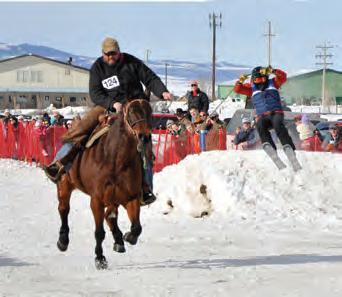

SKIJORING IS BACK! It’s about to get a little more western in Teton Valley this winter. After a six-year hiatus, the epic winter sport that combines skiing and horseback riding (yes, you read that right) is making a comeback. Teton Valley Skijor will be held at Tributary’s driving range in Driggs on January 28 and 29. The event is part of the Skijoring America circuit and will welcome professionals ready to compete as well as locals looking to show their stuff. For details, visit: facebook. com/people/Teton-Valley-Skijor.

GET THE GEAR THIS SEASON from local lifestyle brand Give’r Gloves, known and loved by mountain enthusiasts of all types. The celebrated glove and gear manufacturer relocated to Victor this past summer. Kick off your season with a pair of their top-sellers for winter and beyond:
4-Season Gloves These versatile, durable, and waterproof gloves are all-leather, insulated, and will take you from the ski hill to the trailhead, and then some.
Frontier Mittens The mitten version of the 4-Season Gloves with wrist cuffs and waterproof cowhide to keep your hands warm while you’re skiing the line.
Classic Give’r Gloves Known by locals as “the gloves of one hundred uses,” these hardy gloves are lightly insulated, wax-sealed, and ready for it all.









NEW WELLNESS NONPROFIT The Yoga Source, located in Driggs on the second floor of the Old Teton County Courthouse on North Main Street, opened this fall aiming to turn the traditional model of a yoga studio upside down. Founders Ralph Mossman and Sea Marie Biladeau, both longtime yoga teachers, opened the space to provide classes, retreats, workshops, events, and more, as well as to create a hub for the yoga community.
Classes are a “support as you are able” model or can be purchased as monthly memberships. The Yoga Source is a nonprofit run by a board of directors. Ralph explains tha t the board is comprised of himself and yoga students, ensuring that the direction of the nonprofit is led by students, not just teachers.
“The goal is to make it easy for students to come to as many classes as they want and receive the benefits of yoga, which spread to the entire community,” Ralph says. “As I talk to people about this, they get really excited and want to be involved, so I think we’ve connected to something.” More info: theyogasource.org.







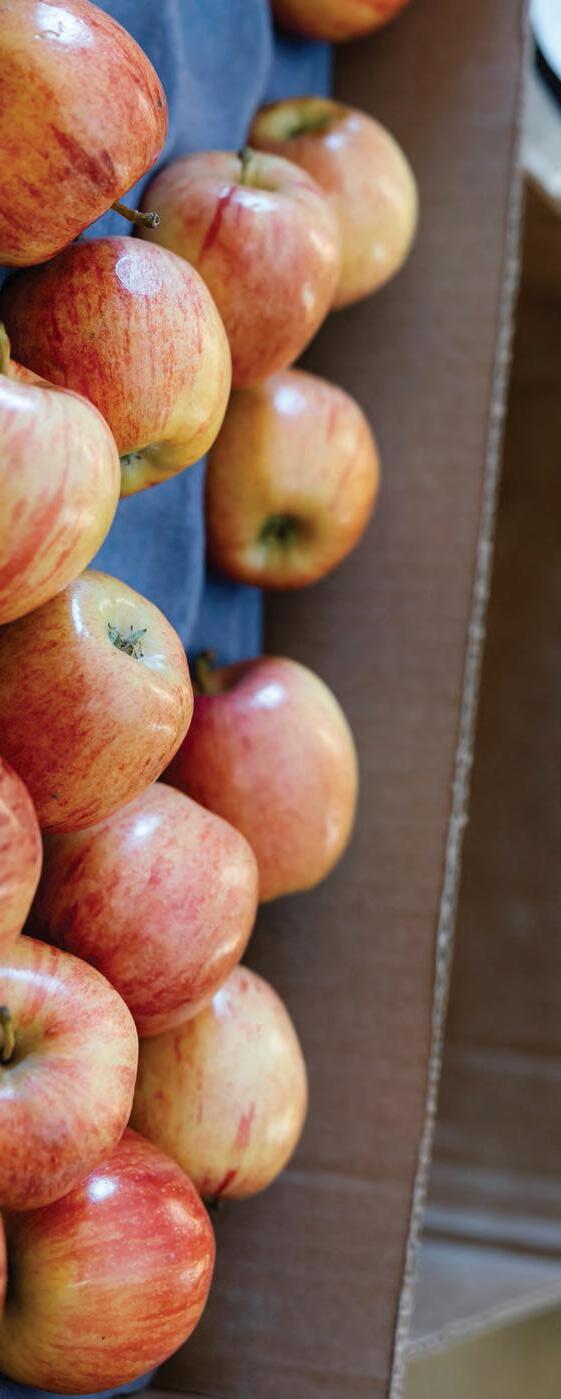







BY MOLLY ABSOLON PHOTOGRAPHY BY LARA AGNEW
Local organizations work to get food on the table (and keep it from the landfill)
The latest United States Department of Agriculture (USDA) statistics show that 89.5 percent of U.S. households are “food secure,” which
means most of us have enough food to support
a healthy, active lifestyle. That sounds pretty good. But what about the remaining 10.5 percent of Americans, or roughly 34.6 million people?
These people—seniors, children, the unemployed, workers whose salaries are insufficient to cover their expenses, people with unexpected medical bills, or those who are unable to work—are forced to make tough choices in order to put enough food on their tables. Choices most of us never fathom, like whether to buy cheap, less nutritious food; leave bills unpaid and gas tanks empty; or skip meals or go hungry
At the same time millions of people face food shortages, USDA statistics indicate that as much as 30 to 40 percent of the food supply in the United States is wasted, ending up in landfills rather than in people’s bellies. Such waste means lost resources as well as lost food. Precious water, energy, and labor used in the production, distribution, and disposal of unused food is squandered with the waste, while methane— a greenhouse gas—is produced at the landfill by the rotting food.
These contradictory statistics are frustrating. How can we have so much abundance and still have people going hungry? Obviously, at least in the United States, we should have enough food. Why isn’t it getting to the right people or even to any people?
Sometimes it’s easy to think this isn’t our problem. Teton Valley, after all, appears to be an affluent place. But looks can be deceiving. The combination of our high cost of living, often inadequate salaries, and lack of affordable housing, plus inflation pushing up the cost of everything from gasoline to potato chips, has forced a growing number of people in our valley to make tough decisions. One of those involves getting enough food for themselves and their families.

Sue Heffron, the executive director of the Teton Valley Food Pantry, says the organization serves more than thirty households in a typical two-hour Wednesday night distribution—their busiest distribution of the week. In 2021, during the five weekly distribution nights per week, seventy total households were served. In 2022, that number grew to more than one hundred households. All told, 13,456 people representing 3,800 households visited the pantry in 2021. These numbers represent total visits to the pantry, including repeat visitors. That’s
IN 2022 , the food pantry estimates that more than one hundred local families were served during weekly distribution nights. This is up from an average of seventy households in 2021.




a lot of usage in a small place like Teton Valley, and the numbers are growing.
The pantry was founded in 2008 thanks to the Rotary Club of Teton Valley and St. Francis of the Tetons Episcopal Church in Alta. Then, the pantry had one distribution per month that mostly consisted of canned goods. Now, the pantry distributes five days a week, offering a total of eighteen hours for someone to come by and utilize their services.
Most of these clients are anonymous. Poverty continues to carry a stigma, and many people are ashamed to admit they need assistance. But pantry users do submit notes of appreciation. One unidentified person wrote, “With the cost of gas and groceries going up, it’s nice to know we can get our fresh fruits, vegetables, and dairy products from [the pantry]. This allows us to put gas in our car.” Another said, “Since moving to the valley, our rent has increased every year. The food pantry is a real help in supplementing our food needs.”
The Teton Valley Food Pantry gets food donations from the Idaho Food Bank, food drives, businesses, church groups, and community members. Local farmers, and the county extension office, grow specifically for the pantry. Plus, monetary donations pour in during the Tin Cup Challenge fundraising event to help round out the budget. Sue and

supplement their supplies, purchasing key items so the food they have on hand for their clients is nutritious, tasty, and what they want to eat.
“Unfortunately, I don’t see the need [for food assistance] ending any time soon,” she says. “But that is why we are

here. Food is a basic need. There’s no controversy in it. You are hungry. You need food? We will help you.”
The pantry is open five days a week, running with the help of Sue and three 36% of Teton County, Idaho, residents were living below the necessary income level required to pay for the cost of five basic household necessities: housing, childcare, food, transportation, and health care. United Way of Idaho Falls, 2019
paid staff, as well as a host of committed volunteers. In addition to regular distributions, pantry staff work with Seniors West of the Tetons to get food to seniors in need. Sue has been known to make special trips to drop off food for individuals and families who can’t get to the pantry to pick up their share. Sue is also excited about the pantry’s work with the school district to provide snack bags with protein bars and fruit to students. She secured a grant from the United Way to purchase snacks so kids don’t go hungry, and teachers don’t have to give up any of their pay to provide for students.
The pantry also collaborates with the library’s Makerspace to provide backpacks to students, among other ongoing partnerships. Finally, the pantry is coordinating with the Above and Beyond the Classroom (ABC) Program in the schools to create food kits with recipes so a family can grab an easy-to-make, complete meal for dinner on a busy night.
Despite the efforts conducted to get food to those in need, there continues to be waste in Teton Valley. Andrea Swedberg first became aware of this when she took on a composting project for Teton Valley Community Recycling. As part of a backyard-composter giveaway, TVCR asked participants to track how much food they composted.
“It was astounding,” Andrea says. “Hundreds of pounds of food went into the composters that [formerly] had gone into the landfill. It’s ridiculous how much food gets thrown away.”
Last year, Andrea took over as the manager of Food for Good, a food-rescue program run by the Community Resource



Your

Turn




Center of Teton Valley. Andrea says Food for Good probably rescues an average of five hundred pounds of food per week, most of it from Broulim’s Fresh Foods.
Volunteers sort food, separating out the items fit for human consumption, which are then distributed at locations in Driggs, Victor, and Tetonia. Andrea says that, thanks to her team of volunteers, giveaways take place six days a week. Food that has gone bad is given to farmers for composting or to feed animals.
“Our mandate has two parts,” she says. “First, we want to keep usable, perfectly edible food out of the landfill. Second, we want to give it to people who want or need it.”

Teton Valley Food Pantry
481 N Main St, Driggs, ID (208) 354-1658
Operating Hours: Mon, Tues, Thurs, Fri 10am-2pm Wed 5pm-7pm
To utilize services, the pantry asks five questions: name, number in household, town, phone, and one income question.
If a family of four grosses less than $5,781.25 per month, they are welcome to utilize the pantry’s services. The income guideline changes based on household size.
Distributions take place in Driggs, Victor, and Tetonia six days a week.
Check crctv.org/food-resources/what-isfood-for-good/schedule for their schedule.
Without Food for Good’s giveaways, Andrea explains, a lot of food would end up in the landfill rather than the food pantry. Their efforts complement those of the food pantry.
The bottom line is, for now, if you need help putting food on your table, there are options in Teton Valley to get healthy, nutritious food for free, no judgment passed.


At St. John's Health, our cardiology specialists are here to care for your heart, whether it’s managing an existing condition, diagnosing and treating potential problems, or helping you reduce your overall risk of heart disease. Comprehensive, compassionate cardiology care is one of the ways we’re specializing in Wyoming, and specializing in you.
www.stjohns.health/cardiology


Driggs. She says her work is meant to be used and

BY JEANNETTE BONER PHOTOGRAPHY BY CAMRIN DENGEL
The studio is quiet, save for the spinning wheel with a single smack of clay centered in front of Chelsea Phelps. “This all feels like a dream,” she says, smiling, as she pushes on the pedal of the potter’s wheel to keep the tempo consistent.
The midsummer sun crests the open windows, casting a bright light onto the hundreds of paint samples tacked to the walls that her husband, Jared, constructed. The quaint but functional studio is tucked beside her home in downtown Driggs where she lives with Jared and their two young boys.
“When I first moved here eight years ago and I saw the Tetons [in person] for the first time, I was like, ‘This is where I want to be,’” says Chelsea, as her arms and hands move back and forth in a familiar rhythm, commanding the clay material to a new life. “But I didn’t have a vision of what I wanted. It took me some time to practice and figure that out.”
Using a wire cutter, she lifts the fully formed cup from the wheel before placing it on a drying rack next to a dozen others of the same size and shape. “I’m gradually getting better every time,” she says.
Chelsea is the creator and owner of Chelsea Pottery Co., a business she shares with Jared, as they both work in cadence to care and provide for their family of four. She describes her creations as functional products that are timeless, everyday pieces. Using foodsafe glazes, her cups and dinnerware are made to be used and loved—and,
for the growing audience of admirers of her work located locally and nationwide, both collected and cherished.
Chelsea’s passion and commitment to practice, as well as her efforts to “figure it out,” are reminiscent of the story of so many mountain dwellers, keeping the tempo steady through the seasons of dreaming and building, birthing and babies. And as she works to carve out a life with the artistic fortitude like that of many modern-day pioneers, she offers up the kind of work that reflects the spirit of creativity often found tucked into the foothills and valleys of the rugged Rocky Mountains.
“You have to be very resilient as a potter,” says Chelsea. “You have to be steady with this work. Clay has memory, so if I’m trying to dry too quickly, the clay will remember I didn’t do all the steps correctly. Pottery is not for the weak and I wish I was always perfect.”


G-Fusion Steak Knives
“Glides through steaks as if they’re butter.
- Wall Street Journal
The Teton-Edge Santoku
“The perfect balance of power and grace.”
- Bon Appetit
Glory Folder
“Razor sharp and gorgeous.” - Forbes

“I love this place and I want that represented in the art that I make. I want people to have a little piece of the Tetons every time they pick up a cup or mug that I have made.”
Chelsea Phelps, Chelsea Pottery
Co.
A New England transplant, Chelsea studied printmaking in college. When she moved to the Tetons, she took to the mountain slopes where she worked various jobs during the ski season, in between finding her own time on the snow. After a bad turn on the ski hill, she replaced her ski boot with a cast and took on a job nannying. Then, she had the time to devote to learning more about pottery and realized quickly that she would have to lean into her skills as an artist if she was going to stay in the Tetons.
“I went to school for printmaking, but I had my hands in every art form,” Chelsea says. “Then I took a community pottery class at Teton Arts and thought, ‘I could


do this.’ And then I said, ‘I’m doing this.’ I love pottery and I love to do it every day.”
Life took shape for her as she made connections through the art community and started working for the late local potter Darin Kerr at the farmers market in Driggs, where she’d sell his work for a commission. It was a foot in the door, so to speak, as she learned the arts of creating and selling. In the meantime, she continued to work and learn through Teton Arts, using the community kiln to practice and find her rhythm and that signature style that now sells out within minutes online and ships around the country. While Chelsea’s work includes platters and bowls and other household items, it’s the cups and mugs that continue to be her most popular items. Each piece is handmade with slightly unique variations in design and color. Stars and
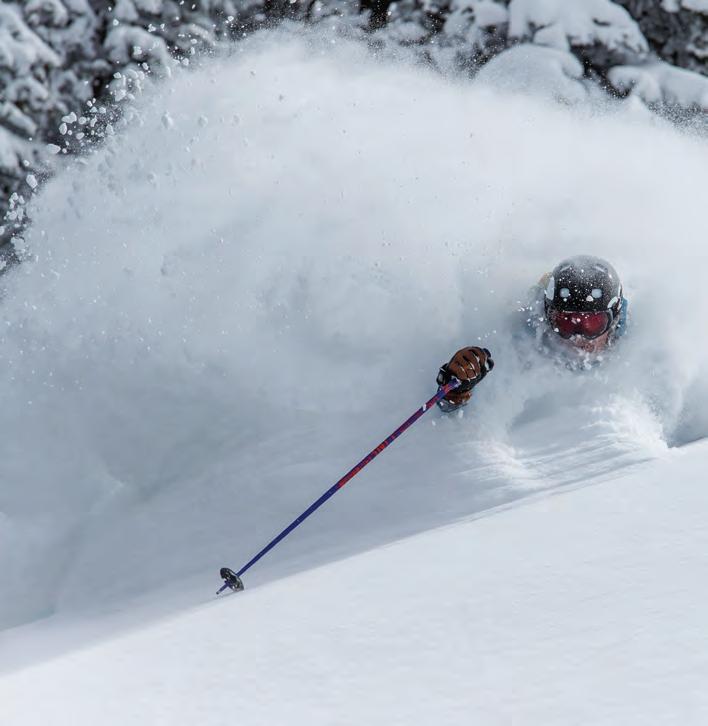











moons, Tetons and rainbows, flowers and snow are hand-etched and dipped in bright glaze with a glossy finish. She says “Ira Blue,” named after her older son, is probably her favorite color of glaze.
“I love this place and I want that represented in the art that I make,” Chelsea says. “I want people to have a little piece of the Tetons every time they pick up a cup or mug that I have made.”
It’s important to Chelsea to create products that are usable, and she admits to spending a lot of time picking up coffee
“You have to be very resilient as a potter. You have to be steady with this work.”
Chelsea Phelps, Chelsea Pottery Co.
mugs in various locations, always exploring the feel for the perfect hand hold.
“I want these mugs to give people joy when they grab that cup of coffee in the morning,” she says. “And that means having a good handle to hold, too,” she adds, laughing.
Chelsea now has a kiln next to her studio that she fills with work for farmers markets, art fairs, and online orders. It takes about four weeks for her to craft enough pieces to fill and fire up the kiln.
“The hard thing about this process is that I can lose all of this at the end,” she says. “There are a ton of little steps to get to the end and, again, I can’t try to rush or skip a step. You have put hours and hours of work into these pots and then the glaze firing can be a disaster, or the pots come out split on the first firing. It can crush your soul.




“I kind of think, though, that maybe that’s the appeal for me,” Chelsea says. “There are so many variables to the art of pottery. I’m pretty good at this now, but then something happens, and I have to work to figure it out.”
She’s happy that sales are good, but also laments that there is often not enough time during the days to produce as much work as she would like. It’s a good struggle to have as she points to a table of postal boxes that Jared will address and pack later after the little ones wake from their nap.
“I’m in love with everything I make,” Chelsea says. “All of this makes me happy.”




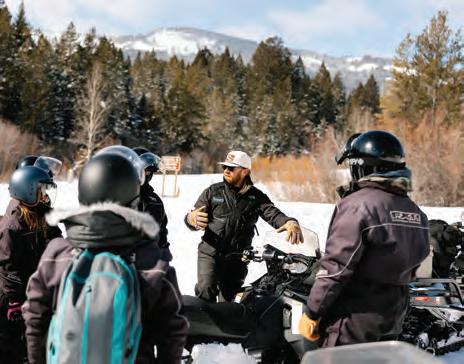


BY P.M. FADDEN PHOTOGRAPHY BY LARA AGNEW
Wintry stillness suits wild lands well. Air turns crisp and the surrounding countryside shines clean as a sugar crystal, but the icing atop this geographical cake is solitude. Cold settles in, snow stacks up, and public access shuts down… or almost.
The valley’s pioneering families are a treasure trove of knowledge and experience for anyone searching for ways to wring the best from any season, no matter how harsh or snow-filled. One founding family, the Moultons, lean into their legacy of exploration and share the uncharted by way of snowmobile.
They’ve been living in the morning shadow of the Tetons since the beginning of the pioneer days. As the family tree has grown, its diverse branches have stretched into various industries, including tourism via their popular snowmobile tour company, Teton Valley Adventures.
Driggs-based but wide-roaming, Teton Valley Adventures is helmed by Travis and Melissa Moulton. Since 1999 their oversnow services have provided visitors eye-popping, roots-forward access to a majesty they call “the backyard” by way of snowmobile excursions.
“Our roots here are deep,” Melissa says. “Travis and I are raising our children on this land. And the Moulton name has probably been around here forever.”
A one-time office worker within the New York City maze, Melissa is a native of Idaho Falls. And husband Travis is as “local” as they come. To both, enjoyment of the land they are working and
raising a family on comes as natural as breathing.
Travis in particular possesses a passion for exploring the wild, especially aboard a snowmobile. The closeness to nature and access to wide-open spaces resonates deeply within him. That connection extends to the entire family. Their daughter already is a skilled, speedy hand on her own machines. And that shared personal “go for it” outlook propels the family business.
“My husband loves snowmobiling all around this area,” Melissa says. “To us, it just made sense to grow that.”
With aims to share an experience and the ethic of enjoying responsibly, Travis directs the sled fleet and a knowledgeable, fully accredited team of guides. Melissa sees to administration, while also looking after the children. And top-tier customer service is central, no matter what the task or role.

It’s a family-sized full plate, yet Travis and Melissa are sure to make time for the hearth. There are four under their happy roof, all believing everything done should reflect the family’s own core values: prioritize people, host






as if in your own home, and always give your best.
“Family comes first, and our client feels included in that,” Melissa says. “We know everyone by name. And it’s amazing to share in their personal stories and excitement. Going out of the way to be a part of the client’s total experience makes it special.”
A key factor in the business is responsible tourism. “We are very much in contact with the National Park Service, the Forest Service, and the grooming board,” Melissa says. “Ensuring things are cleaned and cared for is important.”
The routes Teton Valley Adventures roams reads like a snowmachiner’s bucket list.
“Yellowstone is the most popular, by far,” Melissa says. “It’s a special place to visitors and a big portion of our tours.”
Considering Yellowstone’s sprawl-
Snowmobilers are all smiles on a late-winter tour exploring majestic Teton Valley surroundings.
“Family comes first, and our client feels included in that. We know everyone by name. Going out of the way to be a part of the client’s total experience makes it special.”
Melissa Moulton, Teton Valley
Adventures
ing acreage and awesome wildlife, it’s easy to understand the appeal. And to hear Melissa tell it, the world’s inaugural national park is reinvented when covered in snow
“It’s night-and-day different,” she says. “For starters, the window of access is limited and only a few hundred sleds are allowed. Compare that to the







infinite numbers of RVs, motorcycles, or cars during all the other months.”
But as all-encompassing as Yellowstone is, the iconic park is far from the sole zone the Moulton family explores.
Travis and Melissa roll out full or half-day journeys to Mesa Falls, Cave Falls, and the Big Hole Mountains west of Driggs. Excursions range from enduroesque sixty-mile courses to relaxed jaunts of just fifteen miles. Guide teams have a plan that includes ride-talks on history or fun facts, snacks, and close encounters with colossal nature.
“Mesa Falls is a personal favorite,” Melissa says. “Sharing that view—and snow depth—with new friends is just so fun.
“Total package is the idea,” she adds. “Sled, gear, and customer service; we want to make an unforgettable experience happen comfortably and safely.”
An excursion with the Moulton family feels modeled after the traditions of ranch life. Days begin early and the workload is hearty, but the rewards are greater still.
“Travis calls it ‘free-range living’,” Melissa says, laughing. “We raise our kids like we grew up, free and with fewer stressors. Plus, we like controlling our own destiny with a family business.”
Teton Valley Adventures is an ideal fit, not only for the family’s personal values but also with the basic mentality behind living and recreating in the West.
“I definitely think this area impacts people,” Melissa says. “They want to come back. And we love hearing the clients after a trip. They realize, wow, that was a really big day. And we know it’s not one they’re going to forget anytime soon.”































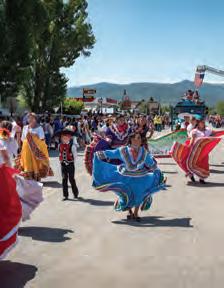
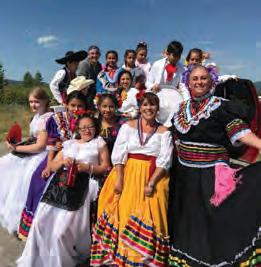
FLORES is a community fixture. She is the founder and executive director of the Hispanic Resource Center, an advocate for the local Latino population, and the Circuit Court Clerk and interpreter at the Teton County, Wyoming, courthouse. Oh, and not to mention her delicious tamales at the Teton Valley Farmers Market!

BY JUDY ALLEN PHOTOGRAPHY BY JAMYE CHRISMAN
Juanita Flores views hers as a life overflowing with opportunity
During the summer of her thirteenth year, Juanita Flores was in for a shock. Having grown up in Tijuana, Mexico, she had just finished elementary school. Then, her family uprooted, moved to San Diego, and bought a house.

“It was awful,” Juanita recalls. “I didn’t know English except for how to order a hamburger and drink. Sometimes I was scared.” But her family made the move because her father, Manuel Hermosillo, had insisted. “Dad had always wanted to come to the North,” Juanita says. Entering legally with visas, he navigated the daunting maze of U.S. immigration regulations, eventually managing to secure permanent resident cards for himself, his wife, and all five of their children, making his entire family legal residents.
Now living in Teton Valley with her husband, Gerardo, two of her three children, and four of her eight grandchildren, Juanita—or Juany, as her friends call her—is a community fixture. Her sunny presence graces the Teton Valley Farmers Market at the tamale booth she shares with daughter, Andrea. Alongside sister Gabby Hermosillo, Juanita is the bedrock of the Hispanic Resource Center, a nonprofit founded by the sisters to assist valley Latinos. Commuting four days a week to Jackson, she’s also currently the Circuit Court Clerk and interpreter at the Teton County, Wyoming, courthouse.
Juanita’s journey from frightened teen to bilingual professional is an in-
spiration. She relocated with her family once more to East Los Angeles upon entering junior high and was enrolled in English as a Second Language (ESL) classes for three hours daily. Hinting at future life successes, she became treasurer, secretary, and president of the ESL student government.
Behind
it all, day to day, is the tireless Juanita. Embracing a life full of opportunities, she’s a translator of her culture, spreading her warmth far and wide throughout the Teton region.
By eleventh grade she was competent enough in English to attend all regular classes. During her senior year, she was a writer for the high school yearbook and, because of her writing work, she won a scholarship to the University of Southern California to attend a summer program in journalism. Following graduation, she attended a year of community college, then a year of business college in business administration. This background, she says, “has gotten me all my jobs.”
At twenty-one, Juanita married Gerardo and had her first child at twentytwo. With her mother Eva’s help raising the kids, she continued to work in the business field, remaining with the same company in Los Angeles for ten years. At one point, she managed nationwide
Idaho







conferences and travelled around the country for work. “I loved flying,” she says. “I’d visit every shop in every airport.” Foreshadowing their future endeavors together, her sister, Gabby, worked for the same company.
With extended family from Tlaxcala, Mexico, the origin city of many Teton Valley Latinos, Juanita came to visit the valley for her brother’s wedding. Her family talked of lots of opportunities and encouraged a move. Her children, who had never seen snow before, wanted to snowboard. Back in Los Angeles, the deciding moment came when she was picking up her kids at school one day. A helicopter circled overhead, police cars surrounded the area, and the school was in lockdown; there had been a shooting inside. “I called my husband right then and said, ‘We’re moving,’” Juanita recalls. “I wanted my kids to grow up in a safer environment.” In August 2002, the family rented a semi and made the move, accompanied by Gabby and family.

During her first year in Teton Valley, Juanita was a stay-at-home mom. “Somehow I thought I’d like that,” she says. “But I was going crazy; I’d never stopped working since I was fourteen.” She landed a job with an insurance agency and then was offered a job at the Teton County, Idaho, courthouse. One day a county employee rushed into her office. They needed a Spanish translator immediately upstairs in court. Again, a serendipitous moment opened a new path for Juanita. Shortly after, in 2005, then Teton County Clerk Nolan Boyle hatched a plan for the county to be the first in Idaho to employ in-house court interpreters. With his eye also on Gabby, he offered the sisters a week of training in Boise. “He was a visionary,” Juanita says. Juanita and Gabby completed the certification process with the State of Idaho and received approval.
Since 2009, Juanita has held her present position as interpreter with the Circuit Court of Teton County, Wyoming. She continues to attend seminars and national conferences to hone her interpreting skills and learn evolving court protocols. In her downtime, she watches television in Spanish with English subtitles to learn current Spanish terms and cultural trends. “I’ve always liked learn ing something new,” she says.
By 2008, as a result of their pres ence in the courts, Juanita and Gabby were getting lots of questions about DACA (Deferred Action for Childhood Arrivals), the U.S. government program that protects children of immigrants from deportation and grants them work permits. The Latino Resource Center (LRC) in Jackson hired Juanita to in terpret for a presentation explaining DACA. Two hundred people attended. In Teton Valley, Gabby and Juanita began meeting in a local home to disseminate DACA information. The City of Driggs then offered office space, and the LRC granted attorney resources. The first DACA application in Teton County emerged from those meetings. After the LRC contributed funding to rent an office, the Hispanic Resource Center (HRC) incorporated as a sepa rate nonprofit and was born as Teton Valley’s own organization.
Dual language immersion offers a rich bilingual experience for young learners when their minds are developmentally best able to acquire a second language.

schools!

A safe and exceptional learning environment where career and college readiness are the cornerstones of a relevant and progressive edcuation. Learn more about student achievement and all TSD 401 school programs at tsd401.org


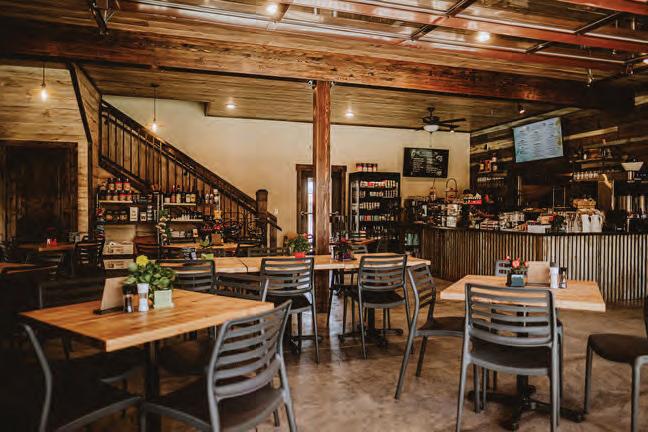
Thus, the HRC evolved out of com munity need, Juanita explains, and she, Gabby, and daughter Andrea serve on




the board of directors, as well as acting as the all-volunteer staff. The most public face of the HRC is the Hispanic Heritage folk dancing group, directed by Gabby. It’s a vehicle for Latino youth to become “conscious and proud of their culture,” Juanita says; “a window to their background” for those youth born here in the U.S. The HRC also hosts events like Día de Los Muertos
“I don’t judge other people. I see an opportunity to help someone.”
Juanita
Flores, Circuit Court Clerk and Interpreter,Teton County, Wyoming
(Day of the Dead), a traditional celebration from central Mexico, where altars erected in Driggs City Center honor deceased relatives. Raised in a different area of Mexico, Juanita was unfamiliar with the holiday herself and learned along with the rest of us.
The less visible groundwork of the HRC is the endless array of services provided to the Latino community: referrals for attorneys and doctors, interpretation of applications and correspondence, as well as educational programs like adult ESL and General Educational Development (GED) test instruction. When the HRC brought the Mexican Consulate to Teton Valley, two hundred and fifty attendees came to receive passports and birth certificates as Mexican nationals, as well as to receive dual citizenship for children born to Mexican parents. Last year, the HRC began participating in Noche de Familia, a monthly dinner held by the high school group Latinos in Action. In future programming, Juanita hopes to provide help with college applications for first generation college students.


Behind it all, day to day, is the tireless Juanita. Grounded in her work in court, she says, “I don’t judge other people. I see an opportunity to help someone.” Embracing a life full of opportunities, she’s a translator of her culture, spreading her warmth far and wide throughout the Teton region. All Teton Valley dwellers are the lucky recipients of the fruits of her talent and commitment.

WOW…Fall River Electric Cooperative, the electric utility YOU own, provides 95% carbon-free power to your home and business!

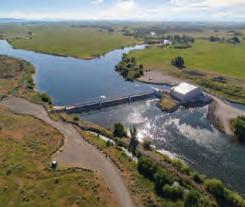



While other electric utilities talk about decreasing their carbon footprint, Fall River Electric has already done it.
Hydropower, produced by our own hydro facilities, and the power purchased from our wholesale power suppliers provide all of the renewable energy we send down the lines to you.
Fall River Electric is an electric cooperative owned by you, the customers we serve, and is governed by an elected nine-member board. We are committed to safely and economically provide reliable energy & other services that are of value to our members.
We are your “Trusted Energy Partner”


BY MICHAEL MCCOY ILLUSTRATION BY VICTORIA HOLLINGSWORTH
Welcome! Maybe you’ve been vacationing in this special spot for years, or maybe you recently relocated and bought a house sight unseen, just because someone told you it’s a great place to live and invest in. (They were right.)
I’ve learned quite a few things during my years here. Perhaps some of them could prove useful to you.
As for credentials, I’ve been a Teton Valley newbie twice myself.
The first time was nearly fifty years ago, when I came to the valley the autumn after graduating from the University of Wyoming. I knew not what I was coming here for; only that I had a free place to hole up in a friend’s uninhabited, unfinished log cabin up Fox Creek. (Teton Valley was quite a different place in 1973.)
The second time was more than twenty-five years ago, when my wife Nancy, whom I met during that long, powdery winter of 1973–74 as a fellow employee—turns out what I was coming here for the first time was to be the night cook at Grand Targhee Resort— moved here fulltime from Missoula, Montana. (And again, Teton Valley was quite a different place in 1995.)
So, for what it’s worth, and in no special order, here are some of the things I’ve learned along the way that might help you start your chapter here.
I’ve learned...
• to stay off the mountain-bike trails when they’re muddy.
• t hat winter, while I love it, can be excruciatingly long ... and to get out as much as possible into the cold snow and brilliant sunshine.
• t o get my tires siped for winter driving.
• t o always carry food and water, a sleeping bag, a shovel, and a tow stra p in my truck in the winter. When you end up in a snow-filled borrow pit, the next pickup truck driver to go by will probably pull you out with her own tow rope. But you’ll want yours for the next time you come across somebody else in the ditch. Pay it—or I should say, pull it?—forward!
• t o also keep plenty of food and water at the house in winter.
• t o preserve my back when shoveling snow by practicing ambidexterity.
• t o drive through Victor at 25 miles per hour instead of the posted, and too-fast, speed limit of 35 mph. (I’ve also learned that it’s tempting to drive at 35 mph on Cedron Road as it enters Victor, where the speed limit is 25 mph. I think they got the speed-limit signs mixed up.)
• t hat even though I’m pretty good at math and geography, I still can’t wra p my head around a road junction
marked by a pair of green street signs reading “W 8000 S” and “S 2000 W.”
• t hat if someone is trashing an immaculately groomed Nordic ski trail by walking or sno wshoeing down the middle of it, they’re probably uninformed rather than uncaring.
• t hat while there may be no such thing as a bad dog, there are plenty of bad (or “uninformed”) dog owners. Please respect leash la ws on trails.
• t hat the vast experience or worldliness you bring with you mean little until you apply them locally—as a nonprofit volunteer, perhaps; getting involved in something that calls on your expertise and/or touches your heart.
• t hat the more local politics become, the more impact the individual can have.
• t o wait a day or two before emailing that letter you just wrote to the editor of the Teton Valley News Then rewrite it and send it.
• t hat the Corner Drug pharmacists treat you more like a person than a number.

• t hat “out below” refers in particular to Idaho Falls and in general to an ywhere west of here in Idaho that’s at lower elevation.
• t hat some people can grow toma toes in Teton Valley and I’m not one of


Silver Star takes great pride in connecting our community to what matters most. We started as a telephone company and have evolved to provide broadband internet services. Our fiber network has the most cutting-edge technology available with speeds up to 1 Gig—that means fast, reliable internet that can be scaled as your needs grow. Future-proof your home or business from a local provider you can trust.
them. (As a major consolation, I’ve also learned the location of some of the best huckleberry patches in the Big Holes.)
• t hat eggs produced by local freerange chickens have really yellow yolks and really great flavor.
• t hat when driving on the highway it is both safer and more considerate to leave a big space between my car and the one in front of me.
• t hat I’d rather drive to town surrounded by farm fields than past the ever-encroaching subdivisions.
• n ot to get impatient with the farmer who’s meandering down the back roads in a big Gleaner combine and taking up most of both lanes. I figure the 160-acre field he’s heading to or from, were it subdivided, could hold five dozen new houses. If that happened, how many cars and trucks would supplant that one combine?

• t o smile and give the two-finger “peace sign” wave to those driving the opposite direction on one of our rural roads.
• t o slow down on those gravel roads when meeting or overtaking cyclists, so as not to envelop them in a dust storm.
• t o slow down to the speed limit (or slower) everywhere. A lot of people claim to have moved here for the slower pace of life, and our public highways and byways make grea t places to start practicing that slowness.
• t hat getting stuck in the middle of a cattle drive on Cedron Road is aways fun and funny, regardless of how many times it happens.
• t o tip hard-working restaurant servers at a percentage point tha t would elicit gasps from my late, pennywise, Great Depression-raised parents.

• t o try to not feel incon venienced when my favorite restaurant is closed for the off-season (read: late April–May and late October–Thanksgiving).
• t hat the twin mud seasons are good times to go somewhere else, anyway.
• that “free” music isn’t free; somebody’s paying for it—and that tipping
musicians is a wise move that just might help forestall the arrival of the day the music dies.
• t hat I miss TargheeFest and Tar ghee Bluegrass like long-lost friends, and hope they’ll return for encores after being AWOL for the past three summers.

• t hat a lot of people prefer using horsepower to explore the mountains, whether it’s a one-horsepower Paint or a fifty-horsepower Honda.
• i n winter, snowmachiners often unknowingly create some of the best cross-country ski tracks around.
• t hat the Broulim’s supermarket in Driggs doesn’t close in a blizzard, even when the schools do. Unless the blizzard hits on a Sunday, when it’s closed anyway. (Victor Valley Market and Barrels & Bins, however, are open on Sundays.)
• t hat I don’t run into as many people I know at Broulim’s as I used to. I’ve also learned how to work the self-checkout kiosks; the lines can be unbearably long and it takes some pressure off the staff.
• that it can be symbiotically rewarding to get to know your neighbors. For one thing, it’s nice to be able to walk to and from a party, rather than drive.
• t o buy locally more often; that lower prices and convenient home delivery don’t always translate to the best of deals. The pluses of face-to-face service and interaction can far outweigh the savings of a few dollars.
• t o respect and admire landlords who sacrifice some potential earnings by renting to long-term residents rather than to itinerant AirBnBers.
• t hat development is inevitable. Ten years from now residents will look back and say Teton Valley is quite a different place than it was in 2022.
Finally, I’ve learned that not all of the onus to get along is on the newcomer. I’ve observed plenty of “locals” behaving badly as of late. And really, what makes a local? I believe it’s more a matter of outlook and demeanor than roots or longevity. Be nice! Be kind! And expect the same from others.
Your title company for the past, present and future
We take our jobs seriously. When investing in a new home, a new site for your business, or your own Private Idaho ‘getaway’ you need to have peace of mind that the property is truly yours and that the closing is handled professionally. Please feel free to call us…we’re here to help! 18 N. Main St. Suite 300 Located inside the Colter Building Driggs, Idaho



Our remote, rural valley may take a little extra effort to navigate, but the rewards are great.
Winter is a celebrated and popular time of year in Teton Valley. Here are a few tips for navigating the snowy season,while being a great visitor:
• Be early, for everything. Whether it’s hitting the slopes at the resort or going out to eat, get there early and you’ll be amply rewarded.
• Be self-sufficient. Carry water, snacks, extra warm clothing, and first aid supplies on your adventures.
• Be prepared. Start at the Geo Center, Forest Service office, and local outdoor shops and load up on local intel for your winter adventure.
• Be patient, kind, and respectful of the people, animals, and ecosystem
• Drive slowly. As we like to say, you didn’t come here to be in a hurry.
• Seek out local goods and be generous to the hardworking staff.






A small-fry nonprofit turned community staple
BY CHRISTINA SHEPHERD MCGUIRE


“Instilling the love of skiing was the takeaway...”
Compared to nearby Jackson Hole, Teton Valley is often viewed as the underdog when it comes to snow sports. The world-class terrain at Jackson Hole Mountain Resort is a household name in the skiing community and attracts international travelers to the eastern slope of the Tetons. Over here in Teton Valley, though, we like it that way. Flying just under the radar of Jackson keeps the snow at our home resort of Grand Targhee a lot fresher, and our community much closer knit.
Still, while we used to be a blip on virtually no one’s radar, our ski and snowboard community has grown, and organizations like the Teton Valley Ski Education Foundation (TVSEF) are prospering. The word is out. Teton Valley has shown up to the race.
“We’ve grown a lot over the past ten years,” says TVSEF head snowboard coach Josh Johnson. “Now, we show up to events and other teams are like, ‘Oh [bleep], the Targhee team is here!’”
TVSEF race director Fletcher White concurs.
“One thing that’s cool about our team is that when we have six competitors, four will make it to the championships; when we have thirty kids, twenty will go to championships,” he says. “We are consistently ranked second or third in the ratio of kids participating to those invited to championship events. And we compete in one of the hardest divisions in the country!”
Navigating the road to creating a robust ski program in a cow town without even one stoplight took much more than perseverance from a core group of local enthusiasts. When Grand Targhee Re-
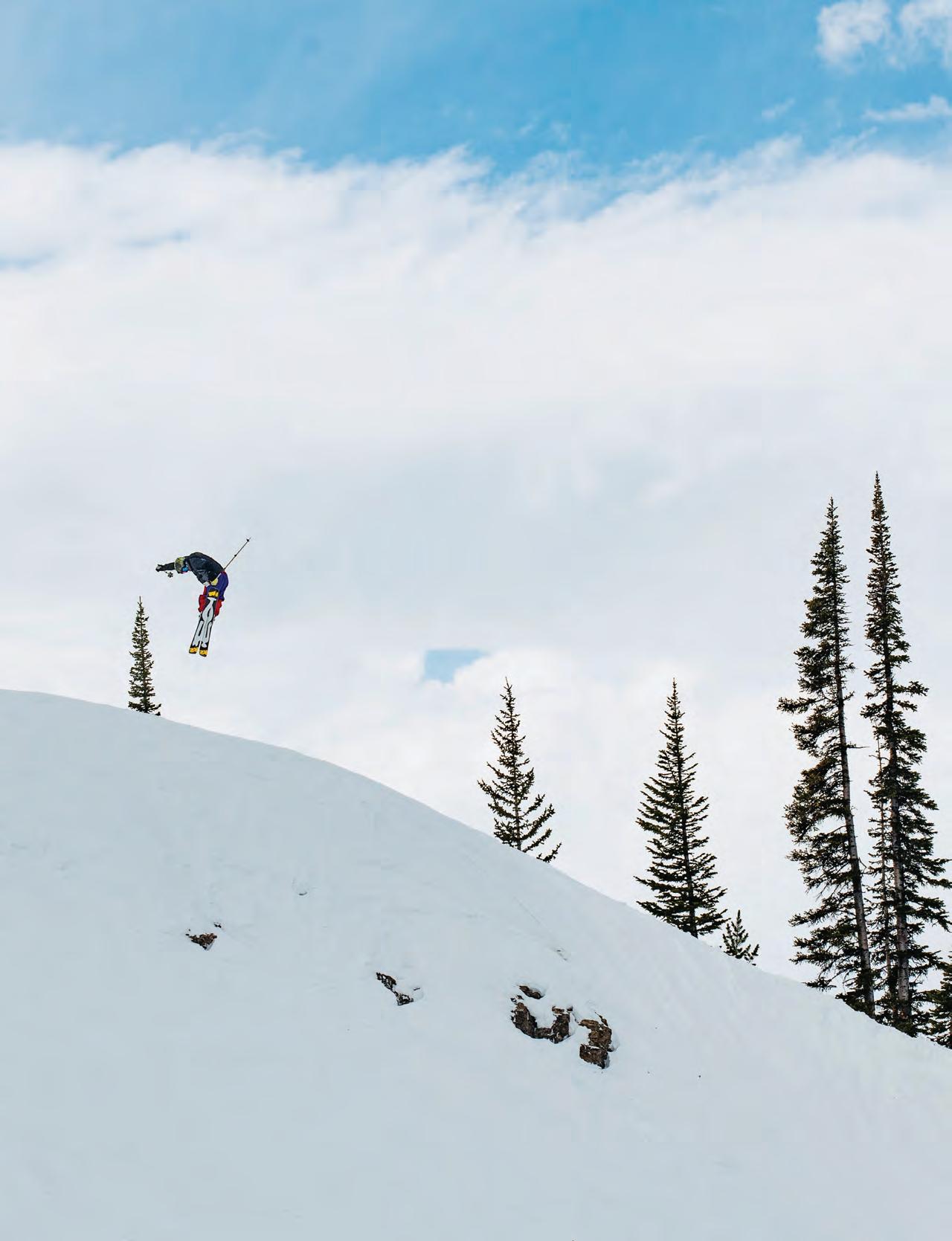
sort opened in 1969, along with it came the development of a ski club and an alpine race team, complete with coaches Terry Palmer (fondly referred to as “Tugboat”), Jessi Smith, and Scott Montgomery. The team produced some great skiers but ended up dissolving sometime in the seventies due to lack of organization and volunteers. Then, in 1987, coach Tugboat was tragically killed in an automobile accident. The family of this beloved college-graduate-turned-“ski bum” set up a fund in his name, earmarked for local ski kids who wanted to train.
The ski community rallied to make the bank account grow, knowing very well that when their kids would come of age, they would need a team to call their own. Dana and Deb Mackenzie, Mark and Brad “Squeak” Melehes, and John “JB” Borstelmann combined forces to make that wish a reality.
First, Deb set out on a recon mission to the Jackson Hole Ski Swap to observe the process and check out their systems. In November of 1988, she replicated the efforts in Driggs,

hosting the very first Tugboat Memorial Ski Swap to raise money for the developing ski team. They used the money, and Tugboat’s fund, to acquire gates, radios, and the equipment needed to coach. Then, they collaborated with Larry Williamson, the mountain manager at Grand Targhee Resort at the time, to secure a place on the mountain to set their gates. In the season of 1988-1989, the Grand Targhee Ski Team was born, and the group created one of the valley’s very first nonprofit organizations, the Teton Valley Ski Education Foundation.
Future professional big mountain skier Sage Cattabriga-Alosa was the first to sign up for the team, paying a $25 fee. Fourteen others followed to form a fullfledged posse that trained on weekends and holidays with volunteer coaches: Dana, Mark, Squeak, Jerry Lucey, Don Vorhees, and JB. Three years later, TVSEF hired their first coach, a Bulgarian skier named Jordan Kolev, and the kids competed in Jackson’s club series races and National Standard Race (NASTAR) events.
Snowboarding came onto the scene in 1995 when the TVSEF board enlisted local snowboard instructors Misha (Thompson) Melehes and Steve Grant to head up a program. That fall, the riders held the first Board Bash, a snowboard movie premiere and raffle at the Spud
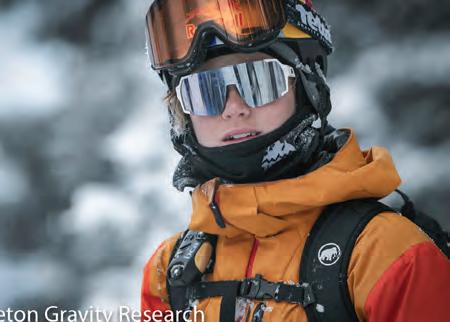
“It was always about fun [with TVSEF] and really nothing else. That vibe has contributed to why I love skiing and why it makes me so happy.” – Kai Jones
Drive-In, complete with donations from numerous snowboard companies and shops. This event marked the beginning of TVSEF’s scholarship fund for both skiers and snowboarders. Today, TVSEF continues this tradition, partnering with the action sports media company Teton Gravity Research for a trunk-or-treat and movie premiere to kick off the season— the event was held at local ski company Sego Skis this past fall while the Spud rebuilds the big screen that succumbed to an April 2022 windstorm.
After the ski swap ran for a few seasons, the event netted $35,000, allowing the TVSEF crew to ramp up their programming. They started cranking out some fierce competitors, but the group’s achievements were often overlooked by the community.
“The community wasn’t really a ski community back then,” says Deb Mackenzie. “It’s such a different time now.”
Deb operated as fundraiser and Dana as program director for twelve years, seeing their three kids, Gary, Max, and Kelly, through the program. When they stepped away, TVSEF’s head alpine coach Dani Allred took the helm and continued the program’s success. Then, in 2007, World Pro Mogul Tour champion Scott Kauf slid into the director’s role, with Brady Johnston as head coach.
At the time, athlete registration was approximately one hundred skiers and snowboarders strong and included Scott and Patti Kauf Melehes’ children, Skylar and Jaelin. The Kaufs’ background in freestyle skiing (Patti was a three-time World Pro Mogul Tour champion and X-Games ski cross medalist) advanced the organization to a level that aimed to give the athletes “as many ski experiences as possible.”
“Throwing it all at the kids (alpine racing, mogul skiing, freestyle skiing, big mountain skiing, and snowboarding) gave them the opportunity to figure out what they did or did not like,” says Scott Kauf. “Instilling the love of skiing was the takeaway … a lifetime involvement in the sport. That’s what we wanted.”
Both of the Kauf children have grown into careers that prove a lifetime love of the sport is what they received: Skylar Kauf spent time as the marketing manager at Grand Targhee Resort, and Jaelin is living the dream as an Olympic medalist, taking silver in the women’s moguls event at the 2022 Winter Games in Beijing.
“What I remember most is hiking Mary’s and the cliffs above [the Sacajawea high-speed quad chairlift at Grand Targhee], building jumps with other kids, and hucking ourselves off of them, and learning how to flip and spin,” says Jaelin. “It’s crazy to look at all




these competitive mogul programs now, and then reflect on what I was doing at twelve years old.”
She recalls a fond memory of skiing powder with her mom, her brother, and her coaches, Paul Smith and Louis Erikson, on a day they were supposed to leave for a competition at Tamarack Mountain Resort near McCall, Idaho.
“We were all skiing on Sacajawea,” Jaelin says. “It was overhead powder and we couldn’t stop because it was so good! My brother Skylar was trying to rush us because he doesn’t like to be late. But that was the vibe of Targhee. … We were in this program because we love to ski. So, we stayed and skied killer powder, and then trained for the comp the next day.”
Skylar has similar memories. “It’s my childhood in a nutshell. … We were up at Targhee all the time—early and late, and on weekends,” Skylar says. “It was our home away from home. My dad’s background in freestyle skiing brought a new element to TVSEF. We started skiing bumps and big mountain lines. ... I still think it’s crazy that an Olympic bump skier [his sister Jaelin] came out of Targhee, given the lack of bumps on the mountain.”
Today, TVSEF continues growing, thanks to its village, which includes former executive directors Corey McGrath and Tim Gibbons, and current executive director, Bridget Baumeister, alongside coaches and countless volunteers. This upward track has landed the organization at a total of two hundred and five ski and snowboard athletes, thirty-five coaches, nine board members, and one administrative staff member. The program continues to include all snow sports disciplines: alpine, freeride, Nordic skiing, and snowboarding. One hundred and fourteen kids are enrolled in the organization’s developmental program, while the rest of the athletes take their spot on competitive teams.
Additionally, last year TVSEF gave out forty-seven scholarships. “In total, it was just over $21,000,” Bridget says. “One in every five athletes receives a scholarship.”

Bridget praises the community support over the years from key community members and businesses like Grand Targhee Resort; Dick Weinbrandt, the owner of Driggs athletic gear store Peaked Sports; and a plethora of other community members who give to the organization in various ways.
Today, TVSEF offers several different scholarship funds, with additional help from John and Susan Love and Streubel Legacy Scholarship (cross-country skiers), the Doug Coombs Foundation (low-income athletes), Pete Dexter Scholarship (first-time competitive athletes), Rich Beesley Alpine Race Scholarship, and Waterloo Sparkling Water Corporation (competition-specific fees).
As for accomplishments: last year, the race team sent multiple athletes to regional championship events in every age group, including Declan White (U16), Ryder Chircop (U14), and seven U12 athletes The freeride ski team had two athletes, Cooper Watson (currently ranked third nationally) and Nathan Cyr, attend the IFSA North American Junior Championship (NORAM) event. Snowboarder Willow Newton (currently ranked fifth in the nation) attended the NORAMs, as well.
New to TVSEF last year, the academy program for competitive athletes allowed kids to leave school early, complete their work online, and train with their coaches from 1pm to 4pm. Eighteen kids took advantage of this additional training.
“Looking at other peer institutions, we realized our athletes weren’t getting
as much time on snow, so we needed to figure out ways we could increase that,” says Bridget.
“There is way more access now to train [here], and some leniency with school, too,” says Skylar, recounting his own experience of relocating to Steamboat Springs in high school to pursue bump skiing. “We’ve become more of a ski community, and that shows in how accepted and available pursuing winter sports is.”
It’s not competitor statistics, or the time off of school, that formulate the backbone of a small-fry program like TVSEF.
For Gary Mackenzie, TVSEF head freeride coach, former athlete, and son of founders Deb and Dana, it’s about creating a life-long love of skiing in a safe environment, while also developing a sense of community. It’s the day-to-day habits and values the athletes share that ultimately foster this type of bond.
“We want to make sure that if we’re going to give it 110 percent on a given day, that, number one: that day is a good day to do so,” Gary says. “We also take account: who ate breakfast, who stayed up late, who has the appropriate layers, and who is going to be comfortable for the day. Making sure kids are eating lunch and drinking water … Being a coach’s coach, and parents’ coach … Coaching parents on how to deal with their athlete … That’s all part of building the community.”
Fletcher White says that ski racing is more cut and dry.
“If you have a bad race, you get out there and do it again,” he says. “[Ski racing] helps kids navigate disappointment, but it’s also very incremental. They see if they put a little bit of energy into it, their results improve.”
Fletcher says this builds confident, comfortable kids that can look failure in the face. And he sees this in his own kids.
“They understand what a tough day is like, and they get over it,” he says. “They are very level-headed—ski racing has given them a good part of that.”
Interim head Nordic coach Victoria Hollingsworth expects curiosity, integrity, and kindness out of her athletes, something the group has consistently delivered on over her four years with the program.
“We show kids how to problem solve within the context of Nordic skiing, and teach them how to manage themselves,” Victoria says. “When they go out into the world operating on those two principles, it allows them to give back to both themselves and their community.”
For snowboard coach Josh Johnson, it’s not about creating the next Travis Rice or Shawn White. Instead, he likes to teach mountain awareness at a young age. “What direction is the weather coming from? What’s a cornice? What are snow facets?” he asks. “I want to teach a general respect for Mother Nature.”
While the weather often dictates the training conditions at Targhee, these conditions aren’t always the ones typically experienced at other, more polished mountains. Our racers don’t train on ice; we don’t have a mogul or slopestyle course on the ready. And a halfpipe? Well, you’ll need to travel over Teton Pass to find one. But this growing organization located in this very special place has proven that the underdog—the one who skis and snowboards in all conditions, and rallies countless volunteers and local support—truly comes out on top, not just as an athlete, but also as a quality community member.
“I have always taken pride in the ‘little engine that could,’” says Todd Jones, former TVSEF board member, a dad, and the founder of Teton Gravity Research. “It’s that gritty vibe—these kids are born on the mountain and TVSEF is their teacher.”



THE COUNTY WILL NEED TO ADD 1,580 HOMES by 2027 to meet the growth of the community.
OPPOSITE PAGE Former Driggs city council member Ralph Mossman and his wife, Mary Mullaney, have seen the boom-bust cycle of the real estate market continue for the thirty years they’ve called the area home.
looking to lay down roots in Teton Valley, watching prices skyrocket far past affordable over the past couple of years has been discouraging.
Government officials and individual homeowners are scrambling to provide solutions to the growing crisis, but will it be enough to keep vital members of the community from moving away?
Desperate for a place to live, David and Terri Rhoades scooted their fifthwheel camper into a cavity behind the RAD Curbside shop in Driggs this past summer. Pictures and knickknacks lent a feeling of homeyness to the small living room and kitchen; folding chairs lined a small, outdoor carpeted area where Terri could watch their Yorkie and Chihuahua mix, Star, while the pup stretched her tiny legs; the rumble of garbage trucks was their background noise.
“It’s even sad to look out the windows,” says Terri, who can’t walk far due to lingering disabilities from a car accident and spends most of her time in the camper. “I got gas silos on this side,” she says, pointing, “and dumpsters on this side.”
Without other options and with the blessing of Dave Hudacsko, owner of Teton Valley’s trash collection company RAD, they moved in temporarily behind the company’s warehouse after being forced out of their rental in February 2021. Dave fills a crucial, often overlooked role helping his employees stay in the valley. With continued unstable housing, David and Terri say, they will

be forced to leave, and he will vacate that position.
Now, they find themselves in yet another temporary fix with their camper parked at Teton Valley Resort. They considered renting a house, but prices made that out of reach. “Just to rent a room and share a bathroom is a third of my paycheck,” David says. “And if you want to rent a house, I just can’t afford it.”
Their struggles with housing, reflected many times over across the valley, reveal an accelerating affordability crisis, one spurred on by recent trends but rooted in the area’s history.
“That’s kind of been the history of this place, that boom-bust cycle,” says Ralph Mossman, a glass blower and former Driggs city council member who moved to Driggs in the late 1980s. At that time, “everything was for sale,” he says, following a 1970s era of subdividing and speculation and a subsequent downturn. In the late 1990s and early 2000s, economic growth fueled more subdivisions and second-home purchasing. Responding to rising prices and limited rentals, Teton County created a Housing Authority, a governmental agency tasked with affordable housing development.
The 2008 global financial crisis, brought about in large part in the U.S. by large banks’ subprime mortgage lending, brought that period of growth to a screeching halt. Recession cratered prices, opening supply and leading the Housing Authority to disband before it ever broke ground on a project.
“No one really had the foresight to keep moving forward and use that as an opportunity to acquire property and try to get a foothold really on this issue ahead of the next wave,” says Doug Self, community development director for the City of Driggs.
Jo Wildnauer wanted bigger mountains. The Vermonter moved first to Jackson in 2013, then eventually to Victor, where she found an above-garage apartment where she stayed for seven years. Her story is rare in Teton Valley, and she was likely lucky to find it, because even then the factors driving today’s housing crisis were brewing.
The 2014 Housing Needs Assessment found a 3 percent rental vacancy rate, half the recommended minimum
BELOW Will Haywood (pictured), and his wife Aska Langman, are using alternative building materials to construct a less costly stick-built home on their property. Their current manufactured home will then become a rental.

6 percent, and determined that over 25 percent of Teton Valley households were cost-burdened, spending at least 30 percent of their gross monthly income on housing. By 2018, rental prices had skyrocketed 40 percent for a one-bedroom house and a whopping 137 percent for a three-bedroom (from $937 to $2,310 per month). And then the 2020 COVID-19 pandemic threw a hand grenade into Teton Valley’s housing market.
Across the country, people flocked to towns viewed as safer in the face of viral spread. With ample recreation opportunities and more amenities than many other small communities, Teton Valley was high on the list. “Rentals that we used to have where secondhomeowners would have a property and they would rent it long term, a lot of those are being converted to short-term rentals,” Doug Self says. “We’ve also seen a lot of people moving into their second homes or people just relocating here.”
What he points out aren’t abstract trends. Wildnauer’s rental was stable “until AirBnB,” she says, when she joined the 18 percent of tenants who moved between 2018 and 2021 because their landlords switched to short-term

renting. The owners of her house sold in December 2020 to a new couple who raised her rent significantly, from $800 to $1,300, she says. She stayed, however, but when her yearlong lease came up for renewal, she discovered they had put the main house on AirBnB and were moving into the apartment. “They never told me what they were doing,” she says. Finding a new rental became a second fulltime job, she recalls.
number that slightly exceeds the 1,580 homes needed by 2027 to satisfy the need for Teton Valley workers and those who commute to Jackson and regional cities, according to the group.
On the home sale side, “explosive” might best describe the growth in prices, to illuminate both its trajectory and destructive nature. In 2019, the year before the pandemic, 73 percent of homes sold in Teton County, Idaho, were under
More than half of Teton Valley renters earn less than 80 percent of the area median income of $68,800.
A report from the 2018 Affordable Housing Technical Advisory Group found 370 entire home AirBnBs in Teton Valley, 6.4 percent of the housing stock, while the Teton Region Housing Needs Assessment published in March 2022 found 250 (5 percent), though that doesn’t capture the true extent of shortterm rentals. Thirty percent of houses in Teton County are second homes, short-term rentals, or vacant properties, totaling 1,600 abodes unavailable for permanent residents and workers, a
$500,000, with 24 percent of those sales under $300,000. Just two years later in October 2021, and reported in the housing assessment, the year-to-date sales showed just 31 percent of sales below $500,000 and a paltry 5 percent lower than $300,000. For a family of three earning the area median income (AMI) of $68,800, an affordable purchase would be $343,000, meaning the market has little they can afford.
Those prices follow similar increases in construction costs and rentals, squeez-
ing residents who fall below 200 percent of the AMI. By 2021, the rental vacancy rate was 1 percent and advertised rents for a three-bedroom were between $2,500 and $3,000, a 166 percent to 208 percent increase from 2014. A household would have to make $132,440 to afford those prices, but more than half of renters earn less than 80 percent of the AMI.
Justine Wysong, who first moved here in 2007, is one of many affected by the price surge. After living in Bozeman, Montana, for awhile, she returned to be closer to her daughter’s father, who lives in the valley. Planning to build a house, Justine bought land, but stringent CC&Rs, a set of rules governing the use of a certain piece of real estate typically in a subdivision, coupled with rising building costs, make building a larger home out of reach. With construction prices around $500 per square foot, she says, a builder “quoted me $1 million for a 2,000-square-foot home.”
Wysong would like to build a house large enough for her daughter to live with her full time, but instead she bought a shipping container home and pays $800 per month to rent a space for it since her property doesn’t allow such structures. She’s lucky to have a roof over her head, she says, but “the reality is I still don’t have my daughter living with me full time.”
Shawn Hill, chair of the Teton County, Idaho, Joint Housing Authority Board, is not immune to these struggles. The former senior planner for the Town of Jackson resides in a stable, manageable rental, but he has no hope of buying a house. “Because of the combined inaction on my part and the accelerating market, I am going to have to find a less desirable place to live in the future,” he says.
Re-formed in 2019, the Housing Authority is “the entity that can maintain or manage housing for long-term affordability,” Teton County Commissioner Cindy Riegel says. “It’s a critical piece.” It coordinates projects and works with local governments to implement policies that encourage affordable housing development. In general, governments the size of those in Teton Valley lack
the capital to build affordable projects outright, so they work with developers willing to build affordable housing, which can be harder to finance and is less profitable than market-rate building. Governments can provide tax credits, land, or the institutional clout needed to secure federal grants.
According to Hill, governmental involvement is essential to building the scale of affordable housing needed.
The COVID-era factors that drove this area’s growth—working remotely, second-home purchasing, and short-term rentals—won’t disappear, so non-local demand, which accounts for a signifi-
Street in Driggs (forty units), and in Driggs’ Gemstone Subdivision (one hundred and thirty-five vacant lots) for further development.
Like with everything in government, resources are the limiting factor. Voters in Driggs and Victor recently approved a doubling of their lodging taxes from 3 percent to 6 percent and allowed those funds to go toward city capital improvements, which includes affordable housing projects, but those collections will likely cover feasibility studies and planning efforts, not construction costs. “Until there’s some revenue available to actually provide solutions, there’s just

cant part of recent home sales, and resources will continue to price out locals. “The amount of outside wealth and outside capital is vast,” he says, “whereas high-amenity communities like ours are finite.”
In 2022 the Housing Authority broke ground on its first project, the Depot Square building. Slated to be move-in ready in July 2023, the building will feature thirty apartments deeded for those earning between 30 percent and 60 percent of the AMI, along with livework units and storefronts that will, for three years, be rented to startup businesses. Though Depot Square was the only shovel-ready project as of this winter, the Housing Authority is targeting sites in Victor’s Sherman Park (seventy-two units), on Front
no way we can actually get over the goal line,” says Troy Butzlaff, Housing Authority board member and former interim city administrator for the City of Victor.
Though the Housing Authority’s projects will provide some relief, they’re not overnight solutions. Depot Square will take several years from concept to completion by the time tenants move in. Other ideas, like foregoing permit fees so homeowners can more easily build accessory dwelling units (ADUs) to use as rentals, have been bandied about for years, but Butzlaff says the board was waiting to hire a Housing Authority executive director before advocating those kinds of changes. In the interim, individual homeowners are left to implement ad hoc solutions.

Some, like Stacy Stamm, offer below-market-rate rentals, foregoing significant rental income. She and her husband, Ian Hosek, moved here in 2018 and built a house, adding an above-garage apartment that they planned to shortterm rent so their friends would have a place to stay. When the pandemic started, they switched it to a long-term rental and, according to Stacy, charge a price well below the average. She doesn’t see them returning to AirBnB at least until the market settles down. “We’re now in crisis mode,” she says about the valley. “We can’t morally do short term.”
Officials, and many renters, wish more landlords could approach their rentals as altruistically as Stamm. Higher home prices have forced new buyers to charge more for rent to cover mortgages, but many renters spoke about having rents raised by landlords who have owned the houses for years and conceivably were covering their mortgages on a lower rent.
Driggs Mayor August Christensen has tried to pioneer programs like connecting non-local second-home owners
with renters for stop-gap solutions. “The city is working to mitigate rent struggles, including limited-to-no availability and homes being out of price range, by developing ways to create affordable housing for people that work in Teton Valley,” she says. “This includes new code for high density development as well as working with Teton County Joint Housing Authority.”
Other homeowners, like Aska Langman and Will Haywood, are turning to new construction, in their case with innovative materials. The couple lives in a “manufactured home,” as Aska puts it, and are constructing a stick-built house. Eventually, their current house will become a rental. However, building costs and months-long waiting times with construction companies make it difficult for many homeowners to afford to build an ADU.
Aska and Will’s situation is unique, in part because he’s in construction and was able to take six weeks off work to frame the house. They are working with architect Lindsey Love, who helped them purchase prefabricated straw-bale panels
from manufacturer New Frameworks in Vermont. Using the panels allowed for overall savings in time and money. Aska and Will raised the frame much faster than if they’d used traditional building practices, and they achieve the same insulating value without less-sustainable foam-board insulation—an example they hope could provide other homeowners a different option. “This is a win-win for us in terms of having the sustainability factor and the speed,” Will says.
Despite the promise of new building materials and affordable apartments, any one of these solutions on its own is incapable of moving Teton Valley past the “goal line,” as Troy Butzlaff put it, of building the 1,580 units needed by 2027, especially considering that 60 percent will need to feature below market-rate prices.

Juan Morales is friendly, accessible, connected, and hardworking. His family moved here in 1997 when he was a kid, eventually buying a house on a land
for a less traditional route to plant roots, like constructing a yurt, as an answer to the exceedingly expensive building costs. Options can be limited, however, with CC&Rs and other building restrictions placed on land.

lease in a mobile home park, giving them some stability, though their land rental fee has shot up recently. Now an adult, he helps the family sell tamales at the farmers markets and runs his own business, Morales Home Made. That kind of longtime local and small-business owner is integral to the fabric of our community, but Juan, like many his age, wants to put down his own roots.
“At some point, I want to own something,” he says, “but with how it’s going, I’m going to have to go in with people just to own land.” Despite the best efforts of the Housing Authority and individual landlords, Teton Valley is losing key members of its community. The Housing Needs Assessment found that it is not replacing families with children as they leave, instead bifurcating into an older population and a younger, seasonal one. Some of those impacts are tangible, as in the Tetonia city government, where Mayor Brent Schindler says he and the city clerk had to cover the public works department for months over the summer because they couldn’t fill an open position.

Betsy Hawkins’ yurt isn’t what you’d expect. Forget any preconceptions you may have of a circular single room—instead, half contains an open kitchen and sitting area, while the other side boasts the framing and drywall construction of a stick-built home. With a clever layout, she tucks two bedrooms, a bathroom, and a loft into half of the roughly seven-hundred-square-foot structure.
Yurt life wasn’t what Betsy envisioned when she moved from “the hills and hollers” of Tennessee to Teton Valley, but she’s hooked. “I literally love it more than I could have ever imagined,” she says.
In 2015, she, her then husband, and their two kids moved west, allured by a desire for change. They bought a modest home in Victor, and she became executive director of the Community Resource Center of Teton Valley, a post she has since left. When she and her husband split ways in 2020, the housing market was heating up. Where she would live became a question with no easy answers.
“There really was no conversation of moving away,” she says. Builders quoted her $350,000 to $450,000 for “the tiniest, most basic box I could conceive of,” figures that were out of reach. Intent on staying, she looked for alternatives. A small apartment was an option, as was an RV, but she wanted a space her kids would enjoy, one that didn’t feel temporary. She found Shelter Designs, a Missoula, Montana, company that makes yurts capable of standing up to the area’s harsh winter weather. After she purchased a parcel of land, friends helped her stand the structure up in April 2021 through a stressful spring storm that delayed putting on the roof.
A carpenter framed in the rooms, and she had enough room for her and her two teenagers at a price she could afford. For those used to the trappings of modern life, yurt dwelling might conjure images of a scaled-back existence, but Betsy has adapted to the space. Books and a yoga mat nestle into the cavities between the studs; her butcher-block countertops and open shelves exude a modern farmhouse atmosphere. Queenie—combination guard dog and resident ham—lounges in the living room. Betsy even bakes bread in the small kitchen, utilizing it—and the yurt itself—to its fullest potential.
“I mean, I’m a cook,” she says. “I do anything and everything here that anybody else would want to do.”

Frankie Owens, the owner of Dory’s Café and Barefoot Fitness and Pilates, has seen it all.
About a decade ago, sight unseen, save for a video tour, she signed a two-year lease on a house in Victor, rented by a family that was moving abroad. They returned early and tried to evict Frankie and her family. After an expensive legal battle that allowed her to stay until she found a new spot, the family found a rental and took everything from the previously furnished unit.
It took Frankie more than six months to find a new place. “So, we hadn’t even been in the valley a year, and we moved houses already.” They then moved into a furnished place for a year, then an unfurnished rental from a couple who moved to Colorado. Frankie asked for first right of refusal to purchase it when they sold. The couple said yes, then went dark. Letters from the bank started coming—the house was in foreclosure. She had no chance to purchase and had to get out in thirty days.
Frankie was in her next place for eleven months before it sold. Then she rented directly from another out-of-state couple, then the same property through a management company, which opted not to renew her lease.
By a stroke of social media kismet, she found a four-year lease at $1,500 per month, ending years of bad luck. Unfortunately, that lease ended in 2022. She was told her rent would probably increase to $2,600 a month, a 73 percent increase. Then, the landlord told her the rent would actually be $3,200 per month, a 113 percent increase. “That, I think, is pretty darn greedy,” Frankie says.
Frankie can’t cover a down payment on a million-dollar home, nor can she find land for a tiny home, which she could afford. This past summer, however, Frankie shared a happy ending to a Teton Valley housing story. She now has an affordable rental a client of hers found.
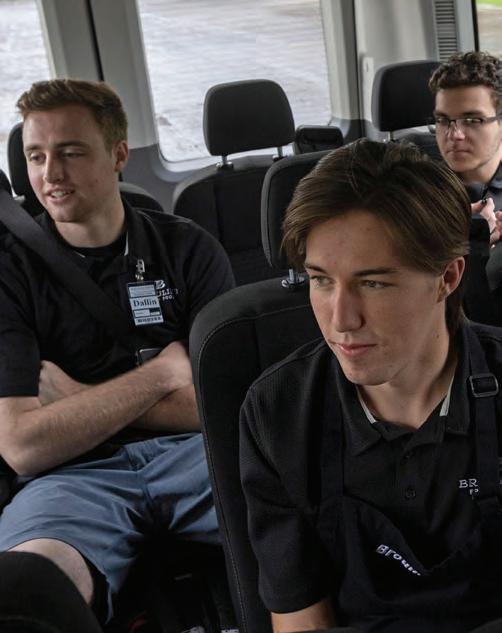
At Tetonia Elementary School, Mayor Schindler says, the administration is also having trouble finding teachers because potential candidates can’t find housing, let alone afford it. That trend extends across the valley: The 2022 housing assessment found 89 percent of businesses in the valley reported being understaffed post-COVID. Many truncated hours of operation because of that chronic understaffing, a hit to their bottom lines.
Losing that middle has another, less tangible impact. It means losing diversity of experience and many in an age group that is often dedicated to actively building community. Parents and others in an age bracket typically in their thirties and forties participate in volunteer events, coach Little League, sit on nonprofit boards, and chaperone school field trips. Betsy Hawkins, former head of the Community Resource Center of Teton Valley, notes that if the only people who can afford to live here are wealthy enough to buy a house, it changes the composition of an area rooted in agriculture. “It’s too bad that we are moving away from being a well-rounded community, where you have all those things and a place for all those to fit in,” she says.
Andrea Flores, whose family moved here in 2002 (learn about her mother, Juanita Flores, on page 46), is a prime example of the potential losses resulting from this housing crisis. She and her

BECAUSE OF THE SHORTAGE of local staffing, a direct result of housing issues, grocery store Broulim’s Fresh Foods busses in employees from surrounding larger communities like Rexburg.
partner, Nick Arens, live in a two-bedroom apartment in Fox Creek Place in Driggs with rent based on their income. But with two kids, they need something larger. Despite the fact that Andrea works full-time for Friends of the Teton River and part-time for Grand Targhee, she can’t afford a market-rate rental. They also want to build equity, instead of watching monthly rental payments dissipate into the ether, but ownership is out of reach for them.
They’ve come to the realization that if they can’t buy something—a plot of land, an apartment, anything—in the next couple of years, they’ll relocate, likely to Iowa, where Nick’s family lives. After twenty years, Andrea will be forced to leave, taking her commitment to civic involvement with her. “I just want to keep giving to my community,” she says. “There’s nowhere else I want to be, but it has become evident that it might not be realistic for us anymore.”
Hers is just one example of stories happening across the valley, situations elected officials are scrambling to avert. But each time it happens it reinforces the transitory nature of living in this valley, the tenuousness of the balance that has been and is being created here. And it reinforces an unfortunate reality that Jo Wildnauer notes: “When you live in a town like this, you just get used to saying goodbye to people.”

Thirteen years. That’s how long Michele Walters felt insecure in the Teton area housing market, and that changed only because she found a benevolent landlord. Michele moved to Wyoming in 1999 to work at the Old Faithful Snow Lodge, then half of her friends moved to Jackson, where she settled, and the other half to Victor. Though she socialized in Teton Valley, the eastern side of Teton Pass fit her lifestyle at that time.
“For me, as an artist, it was a perfect spot because that’s where the clients were,” she says. It wasn’t an easy existence. “I still, you know, was a waitress, and I always had two jobs.” Her first apartment in Jackson was $450 a month, which she didn’t think was cheap back then but sounds unbelievable today.
She spent nearly a decade in Jackson, moved briefly to Victor, then headed back east over the pass for another two years. By then, however, around the late aughts, prices in Jackson were creeping higher, pushing her back to Victor, where she spent the next decade. In those years, Michelle estimates, she lived in fifteen places.
“It was exhausting,” she says of the rental churn. “It almost feels like an abandonment in some way because you just don’t have that stability. You’re constantly worried.”
After more than a decade of bouncing through rentals, she found a place she could settle in and feel comfortable. It was an apartment in Victor, and for the seven years she lived there, her landlord, a formerly struggling artist, charged a reasonable rent. “Bless his heart, he kept it low enough that I could actually start saving so I could buy a house,” she says.
Even prior to the latest explosion in home prices, that type of serendipity has often been required for the non-independently wealthy to buy a home in Teton Valley. Her landlord’s kindness ultimately allowed her to buy a place in Tetonia in 2019. It’s a live/work building in downtown that includes a space for her to live in, a small rental, and a storefront she turned into the Tribe Artist Collective, a studio and gallery space that supports twenty-five local creatives. Twenty years after moving here, after at least fifteen rentals, Michele finally has found security on her own terms.
Of her situation, she says, “You don’t understand how blessed I feel every day.”


VENTURING INTO THE BACKCOUNTRY is an adventure that should always be undertaken with experience, knowledge, and an understanding of what you’re about to take on, from snow conditions to the safety of you and those around you. The same goes for your four-legged powder hound. When conditions allow, skiing with your canine best friend makes for an unforgettable backcountry memory. Knowing what to bring, how to keep your pup and others safe, and, sometimes, when it is best to leave them home, are key.
Teton Valley Magazine met five handler-and-dog duos, all with ample avalanche-safety and dog-training experience, to learn what should go into a backcountry adventure with canines and what these skilled dog handlers consider when heading out.
“Set your dog up for success by having them well trained and socialized...”
– Casey O’Connor
Casey O’Connor + Miko, 6-year-old yellow Labrador
Casey always keeps the overall snow in mind when deciding whether or not to bring Miko along on a ski outing. The pair have ample experience in the snow through Miko’s avalanche dog training at Grand Targhee Resort.
“I always consider these key things when heading out,” Casey says. “Is it really steep terrain? Is the snow going to support him or is there a crust he might be punching through? Is the powder going to be so deep that travel will be difficult for him when the terrain becomes low angle or flat?”
Throughout the winter each year, Casey keeps in mind the balance of travel in steep terrain versus what he thinks Miko can handle, in order for him to maintain great joint health during the later years of his life.
“Set your dog up for success by having them well trained and socialized before bringing them somewhere that might be busy. Be patient and prepared to make it a positive experience for you and your dog.”



Heather Munn + Levi, 4-year-old Border Collie mix
Heather loves seeing her dog, Levi, a former member of the Grand Targhee Avalanche Dog team, enjoy his time leaping through fresh snow. “Seeing how happy he is running through snow is the best feeling,” she says. “He’s my best friend and I love making him happy.” Keeping him safe and taken care of is at the forefront of each outing, Heather says.
“Pay attention to the temperature,” she adds. “When the dog is moving, they are warm. Long breaks from movement makes everyone cold, dog included. Be sure and pay attention to their body language; if they are more timid than usual, picking their paws up, or seem lethargic, it may be too cold for them or too big of a day.
“Dogs will follow their owners to the point of exhaustion,” she adds. “It’s up to us to recognize when they are getting tired.”


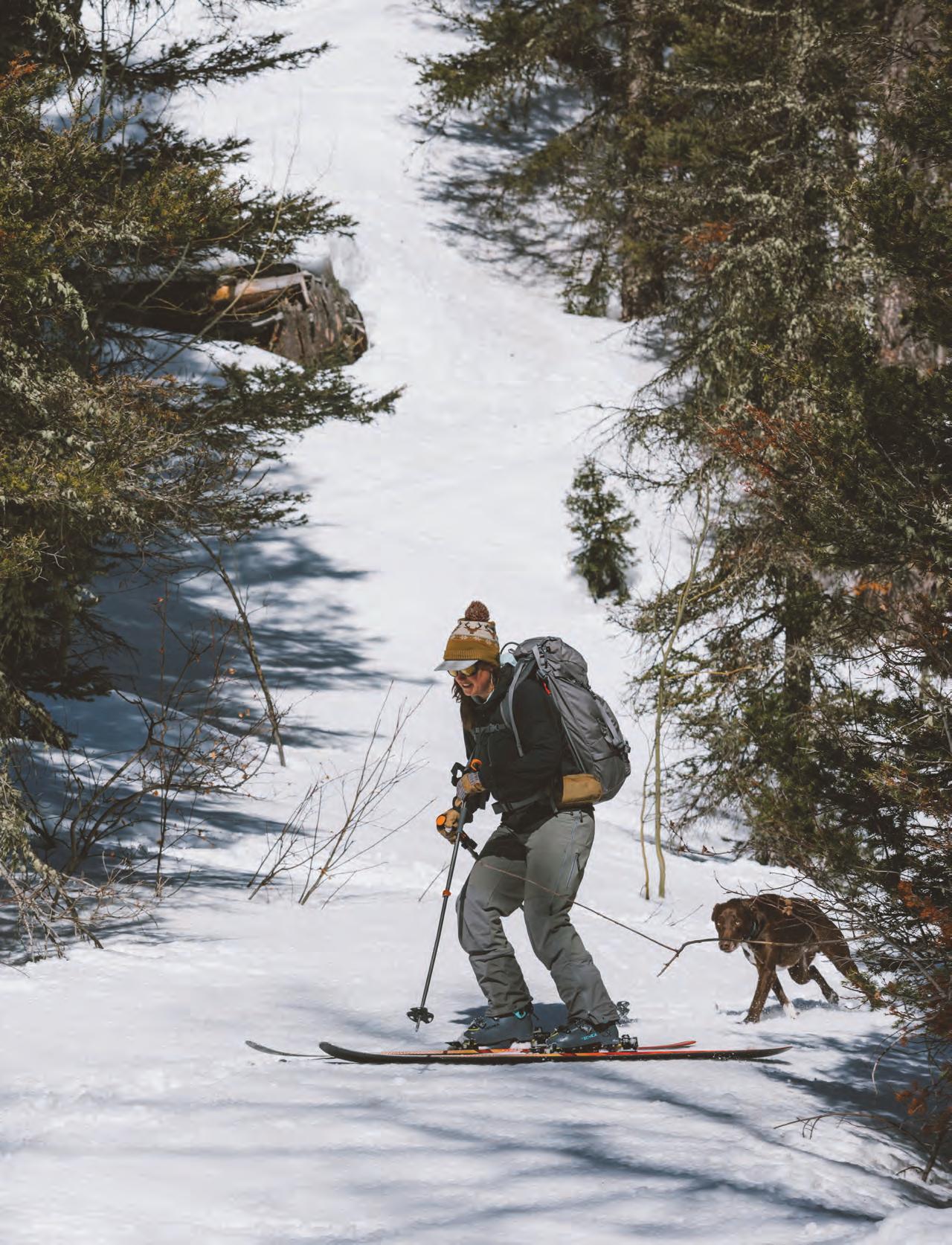
“Dogs will follow their owners to the point of exhaustion. It’s up to us to recognize when they are getting tired.”
– Heather Munn
Becky Hendricks Miller + Yarrow, 6-year-old husky and Carolina dog mix
Becky, no novice to the backcountry, knows that bringing her canine companion, Yarrow, along comes with many factors to consider. “Even though I may love a cold, deep day for skiing, those days aren’t always great for dogs!” she says. “Super cold temperatures are hard on Yarrow’s pads, and wading through deep snow, especially when there is a lot of traversing involved, is exhausting for dogs. I usually bring her on medium- to short-length ski tours, when the powder is not too deep, and temperatures are not too cold.
“I want Yarrow to be able to ski with me for many years to come, and that means protecting her joints and body for the long term, and not over-working her or causing her pain or injury in the short term,” she says.
Becky’s advice for beginners? “Start small and pay attention to how your dog responds to skiing. Practice good trail behavior and training outside of the snow season first and ensure your dog can enjoy the outing both fitness- and training-wise.”



“I want Yarrow to be able to go skiing with me for many years to come, and that means protecting her joints and body for the long term.”
– Becky Hendricks Miller
“And always know when to leave your dog at home. I make up for the days she can’t come with a snowy walk or a game of fetch.”
– Kenny Heidenreich


Kenny Heidenreich + June, 9-year-old, cattle dog mix
Back in her prime, June—who handler Kenny calls June Rambo, thanks to her rambunctious energy—has been a frequent partner on many backcountry adventures. Now that she is entering her senior years, Kenny, who is the spouse of

Teton Valley Magazine editor Kate Hull, opts to only take June on mellow excursions that aren’t too long, but he says she still loves it. “A tired dog is a happy dog!” he says. “When we ski deep snow together, she yelps with joy and just loves it.
“I always consider whether or not it is a really popular trail we are heading out on,” Kenny says. “June does best when it’s just the two of us, or when we are with another dog she knows well. Now that she is older, I also make sure it is an outing that is appropriate for her ability.”
Kenny’s advice for neophytes? “Work on the basics of recall and training at home on the flats. Teaching them to not run in front of your skis is very important. Ski edges are sharp and can easily cut your dog’s legs if you aren’t careful. And always know when to leave your dog at home. I make up for the days she can’t come with a snowy walk or a game of fetch.”

Whenever venturing into the backcountry with your pup, ensure their safety and comfort by bringing necessary supplies. Casey O’Connor always packs his K9 first-aid kit, which includes safety needs like extra gauze and an adhesive bandage called CoFlex.
• Water, bowl, and snacks
• Leash
• K9 first-aid kit with gauze, bandages, and tweezers
• Dog goggles for sunny or stormy days
• Paw wax like Musher’s Secret to protect their pads
• E xtra layers for Fido

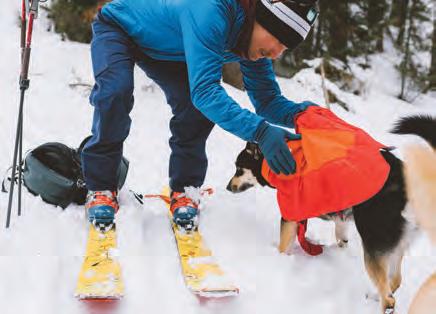
Daniel Nagy + Tele, 3.5-year-old mutt mix
Daniel Nagy is always working to thread the needle regarding his dog Tele’s fitness, health, and well-being so she can enjoy as many fun years as possible—while continuing to do her job as a working avalanche dog. Daniel considers such factors as if there might be other dogs, is it the weekend, how busy of a week has she had, which friends he is going with, and if he feels up to the extra responsibility of bringing Tele along.
“To decide whether to bring Tele, I check what the snow will be like, how deep it will be, and how long the tour will be,” he says. “Rest days are just as important, if not more important, than exercise days for a working dog.”
Daniel’s advice: “Ensure your dog is dialed with basic obedience and has a super solid recall command for safety reasons— not chasing wildlife, running up to other skiers, and more.” Be sure you also know how well your dog handles the cold and that you are prepared with extra layers, for both you and your pup.
“Ask yourself: ‘Is my dog in good enough shape to do this activity?’” he says. “I feel like most dog owners assume their dog can send it off the couch and they mostly can, but should they?”
At the end of the day, for Daniel it’s all about seeing Tele enjoying her life to the fullest. “My favorite thing about skiing with Tele is her stoke for being outside, loving snow, and loving you—also all the snow across her little face as she tunnels and slides her way down. It doesn’t really matter what you skied, they’re just happy to be out with you, and you’re psyched to bring along one of your best friends.”

“It doesn’t really matter what you skied, they’re just happy to be out with you, and you’re psyched to bring along one of your best friends.”
– Daniel Nagy

BY KRISTEN POPE PHOTOGRAPHY BY DAVID STUBBS

THE ALTA NORDIC TRAIL features ten kilometers of groomed crosscountry track with rolling hills and stunning Teton views.
THIS PAGE Nordic skiing enthusiasts can enjoy any of Teton Valley Trails and Pathways’ six trail systems free of charge, but purchasing a $75 trail sticker helps offset the maintenance costs and supports the nonprofit.
OPPOSITE PAGE TVTAP winter groomer Kevin Emery contributes to the cumulatively more than 7,000 miles groomed by the team throughout the season.

We just want people to enjoy winter trails. If it’s walking with their dog or families pulling the chariot behind them, we want those folks to have the opportunities to access that easily, too.” – Dan Verbeten

n a bluebird day, cross-country skiers congregate at Teton Canyon’s winter trailhead, click into their skis, and glide through the canyon, gazing at the Tetons ahead and keeping a watchful eye out for wildlife, such as the moose often seen there. Down the hill in Driggs, families meet up to ride fat bikes or snowshoe on the in-town winter trails, and in Darby Canyon, snowmobilers ride their sleds up the road in search of backcountry adventure.
Teton Valley is home to exceptional winter trails, which are open for everything from cross-country skiing and dog walking to snowshoeing, snowmobiling, fat biking, and other activities. Partnerships between nonprofits like Teton Valley Trails & Pathways (TVTAP) and agencies like the U.S. Forest Service, as well as private landowners and others, help keep the valley’s unique set of quality winter trails open and groomed.
However, development pressure is making the future of some of these trails
uncertain. Last winter brought a new venue—the Teton Reserve golf course—into the system, while Teton Springs fell out of TVTAP’s system due to a decision by resort management to make the course trails private. At the same time, a planned housing development in Driggs caused the in-town trails to shift locations last winter, and further development could threaten a couple of tracks entirely—but TVTAP has its eye on a potential future venue in the Big Holes.
Dan Verbeten is the executive director of TVTAP, which grooms a network of around thirty miles of winter trails at six different venues.
Last winter, he said, the trails had more than 45,000 visits, though automated trail counters can’t tell exactly how many different individuals used them. The trails, however, are no doubt favorites for winter recreationists of all types.
“Teton Canyon is by far the most popular trail,” Verbeten says. “It’s hard to beat that view when you’re starting out.” He says the second most popular
venue last winter was the new Teton Reserve trail, followed by Alta.
He’s noticed good growth at the two “in town” tracks—Driggs and Victor’s Sherman Park—as well. Previously, they weren’t used as often, and he’s excited people are able to easily access these options.
“That’s super exciting for us, because that was always the goal with those tracks,” Verbeten says. “We look at our overall menu of options, and not everybody is going to be an elite skate skier or classic skier, and we just want people to enjoy winter trails. If it’s walking with their dog or families pulling the chariot behind them, we want those folks to have the opportunities to access that easily, too.”
Maintaining and grooming six venues all winter long is a huge project, and a lot goes on behind the scenes. The most visible element to the average user is the grooming and maintenance that occurs regularly, and the online grooming report that is frequently updated in season.

ach of the six venues must have the proper equipment staged there, and machines must be maintained, both over the summer when they’re out of use and when needed during the winter. Storage for the grooming equipment must be arranged, and when equipment needs to be moved between sites, trucks and trailers are required.
Arranging for a site to become part of the TVTAP network involves extensive cooperation and coordination between the organization and landowners, as well as partnership agreements, work agreements, permits, reviews, and, of course, insurance.
When developing tracks, TVTAP program director Nick Beatty focuses on how each one flows, laying out loops and maximizing the terrain, using every little undulation to make the experience the best it can be. However, TVTAP does not determine which uses are allowed at each location.
“Our organization doesn’t determine what’s the allowable use on the ground,” Verbeten says. “We share our experience based on what we know— and that’s accumulated over quite a bit of time—but ultimately, it’s the landowners or managers of the land that make that determination of what is the allowable use in the area. So, we follow what they would like to do.”
Walkers, fat bikers, and snowmobilers are permitted at some sites, while others are reserved exclusively for cross-country skiers. While some venues allow dogs, others do not. For example, dogs are not allowed at Teton Reserve, largely due to an elk herd that winters in the area. The South Valley trails don’t allow dogs in winter due to conflicts that have arisen in the past. Alta allows dogs, but only classic and skate skiing—no walking or fat biking. People can also happily bring their dogs to Teton Canyon, Driggs, and Sherman Park, while being mindful of leash requirements.
“We really look at our full venue menu, if you will,” Verbeten says. “And that is a way in which we try to meet the demand with the miles, but then also provide the experiences so that it can match up with people’s expectations.”
Valley’s growth triggers venue changes
Over the past few years, there has been some flux in TVTAP’s venues. Last winter, as mentioned above, one venue bowed out, while another took its place, and a popular in-town track was relocated due to development.
Teton Springs came under new ownership and discontinued public access starting last winter. “New ownership bought the development, and they were interested in having more of an exclusive resort model,” Verbeten says, noting TVTAP asked for a one-year extension on public access, which the new owners graciously allowed.
THIS PAGE Super volunteer Mike Abbott ensures each trail is in tip-top shape throughout the season, an effort that takes commitment and a lot of hours from TVTAP’s dedicated team.
OPPOSITE PAGE TVTAP executive director Dan Verbeten is excited to see the popularity of the in-town tracks grow. A goal of the nonprofit, he says, is for all people regardless of ability to enjoy access to winter recreation.

The Driggs track near the high school had to be moved due to new development in the area, though its new location is also at risk due to further development. Verbeten says ideally they are looking for sites they can groom in perpetuity, noting some other sites, like Alta, are also at risk as development increases. As new homes are built near the Alta track, the situation could change, though Verbeten says many homeowners enjoy being able to ski from their doors.
Teton Reserve was the newest venue to join the lineup, added during the 2021–2022 winter season, and Verbeten said the first year was very successful. They were interested in becoming a venue several years ago, but at the time, TVTAP was at capacity as far as staffing and equipment would allow. When Teton Springs closed to public access, the opportunity to bring Teton Reserve on board arose.
Bringing a new venue into the trail
system is a complicated process. Beatty spent time meeting with the ground supervisor and staff at Teton Reserve, walking around the golf course, and making sure the track layout wouldn’t damage anything below the snow. He worked to maximize the terrain in a fairly small area, packing loops close together and stacking them to make it easy for skiers to rack up the mileage with a variety of small loop combinations. After a successful first season, TVTAP and Teton Reserve renewed their Memorandum of Understanding for two more years, and both entities are committed to a longer-term partnership, according to Verbeten.
Access leads to renewed popularity
In addition to the venues TVTAP maintains, the Forest Service and other entities manage a number of additional trail systems on public land, and Grand
Targhee Resort features fifteen kilometers of groomed trails for cross-country skiing, as well as trails for fat biking. The resort trails require purchasing a winter trail pass. The Forest Service grooms a number of trails, including Darby Canyon and South Leigh, among others; and Grooming District 33 services some trails on the west side of the valley, efforts funded by snowmobile registration stickers.
Jay Pence is District Ranger for the Teton Basin Ranger District of the Caribou-Targhee National Forest. When he began as District Ranger in 2001, he says Teton Canyon was groomed sporadically with a snowmobile and roller, when he had staff available and when the equipment was working. He received an enthusiastic response from the public, so the Forest Service began to partner with TVTAP to groom the trail more regularly.
Jan Borstelmann has seen the valley’s Nordic skiing options grow dra-
TETON RESERVE was the newest venue to join the lineup, added during the 2021-2022 winter season. After a successful first season, TVTAP and Teton Reserve renewed their Memorandum of Understanding for two more years, with hopes for a longer partnership to come.
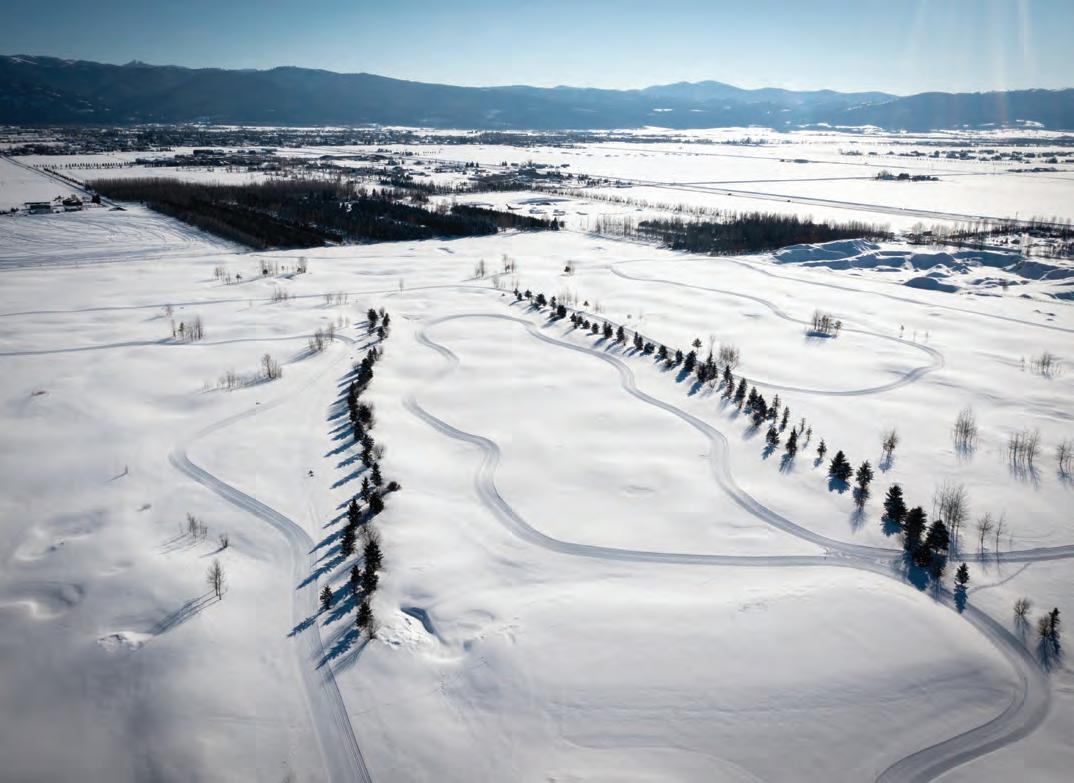
matically over the years. She began teaching Nordic skiing at the Grand Targhee Nordic Center in 1986, and is now co-owner of Teton Nordic Ski School, along with Celeste Young. Borstelmann is excited about how the possibilities have increased over the years.
Borstelmann says ever since TVTAP started grooming valley trails, she’s seen a lot more people show an interest in Nordic skiing. She recalls when a field in Alta was sporadically groomed by people who lived in the neighborhood, but once TVTAP made an agreement with the landowners and committed to grooming, the sport grew in popularity. She says the Nordic skiers in the area used to all know one another, but there’s been a lot of growth in the last decade, bringing fresh faces. “For a long time, we knew who all the Nordic skiers were,” she recalls. “It just seems that even in the last ten years, there has been a whole lot more.”
With winter trail use growing in popularity, it’s not surprising that occasional conflicts can arise. Pence says he sometimes hears from people who are frustrated about different user types sharing trails, like walkers accidentally post-holing in soft trails and snowmobilers heading up Teton Canyon—which is a legal snowmobile trail according to the travel management plan.
“I get a lot of complaints about snowmobiling, but people have to understand that it is a snowmobile trail,” he says. “I think it’s actually working very well. I know there’s a little bit of friction but we’re providing a lot of access to people and opportunities for walkers, classic skiers, skate skiers, and backcountry skiers and snowmobile users… I think it’s a pretty good success story for the amount of use in the area.”
While trail users get along for the most part, one of the issues that has caused tension over the years is dog-related con-
flict. Some venues allow dogs, while others don’t. See page 74 for tips on how to safely ski with your pups, and advice on when to keep them home.
While TVTAP currently maintains six venues, it is also eyeing another site in the Big Holes. The Maytag-Teton Timbers property is around 960 acres, and TVTAP hopes it will be the site of a future Nordic grooming effort, though that is yet to be determined. In 2020, the Forest Service and The Conservation Fund, along with other partners, teamed up to purchase the property and protect it from development.
Now, the Forest Service is working on a travel management plan and deciding if they will allow motorized uses like trail grooming. Pence says different groups, from motorized recreation lovers and wildlife advocates to Nordic grooming


enthusiasts, have different ideas for the land. “We’re trying to balance all of those often-competing needs,” he says.
Verbeten hopes TVTAP will eventually be allowed to groom the old logging roads there, though they would need to do some significant fundraising or implement a fee system to obtain the snow cat they would need for grooming. He says they have a permit to manage the yurt located on the land for overnight stays, and they plan to open it this winter.
While the TVTAP trail system doesn’t require paying a fee to use the trails, the organization asks users to purchase a “trail sticker,” for $75 per person, as well as $25 for a puppy pass. Verbeten says they think of it like a ski pass to fund a person’s trail use during the season. He believes the opt-in model works well and provides access to many, though he says fundraising is always a challenge.
“There are no barriers to people
enjoying it,” Verbeten says. “We don’t force people to pay. We ask them to pay, but we don’t force them, so there are zero barriers for people to go out and enjoy the winter trails.”
And enjoy the winter trails they do. As local nonprofits and agencies work together to shape the valley’s future winter trails, many describe how wonderful it is to have such incredible opportunities locally. Pence points to the socialization that goes on at trailheads, how people run into friends they haven’t seen in months. He likens it to a “mini coffee shop,” and says getting outside and on the trails boosts everyone’s mood.
“If you recreate on the trail systems in Teton Valley, rarely, if ever, do you see someone who is not smiling and having a good time,” Pence says. “Everybody’s always smiling and enjoying themselves.”
For grooming reports and trail information, or to purchase a trail sticker, visit tvtap.org
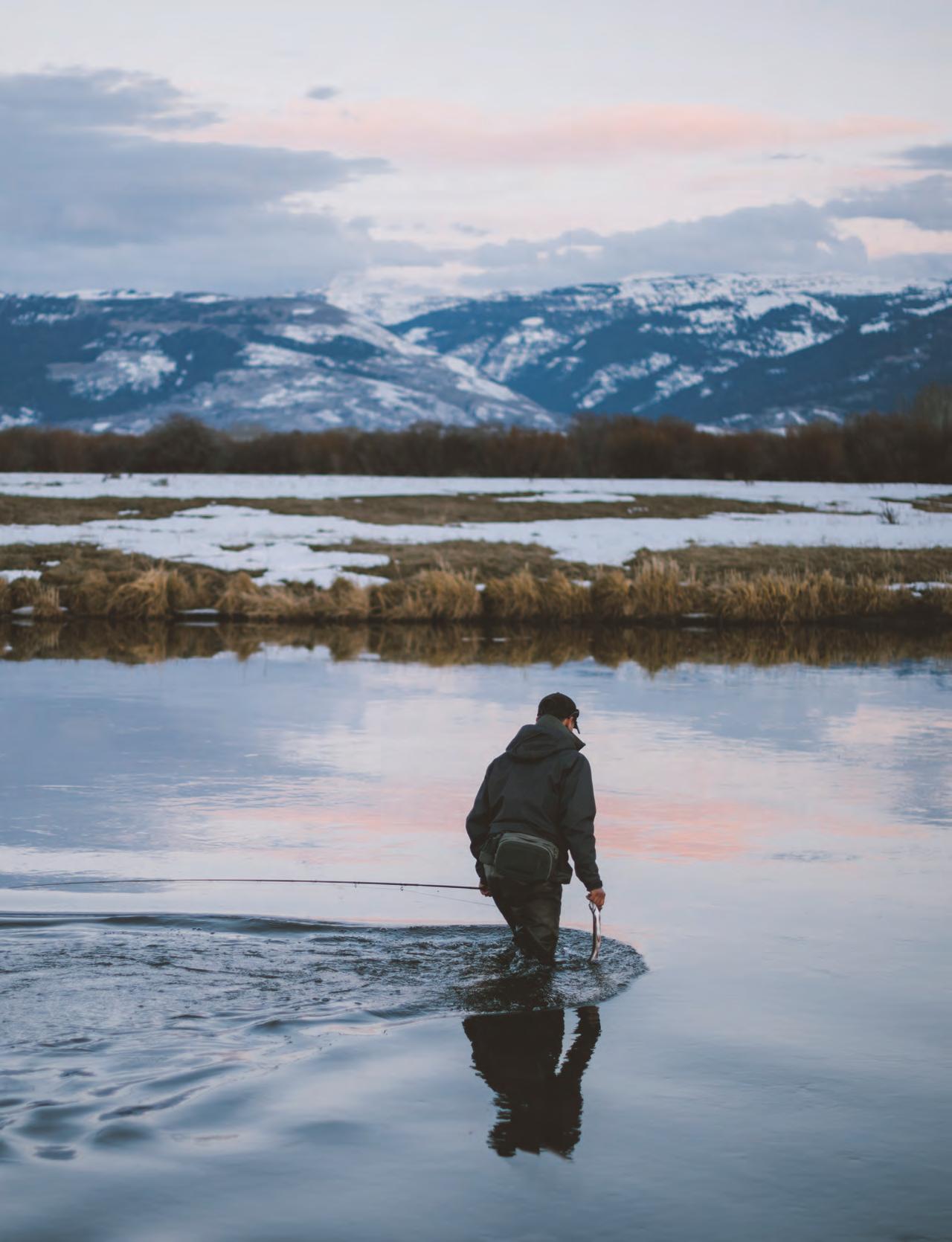



A PARTICULARLY HARDY ANGLER casts a line in search of steelhead as the snowflakes drift down. The location of this Idaho spot? The angler is tightlipped on that one.
BY RYAN ARIANO PHOTOGRAPHY BY CAMRIN DENGEL
Fishing is a year-round sport for some hardy anglers
Your line tightens, your rod bends, and your reel spins. But it’s not a warm summer afternoon. Your breath comes out in steamy clouds, a white frozen landscape supplants the green bushes that surround the water in the warmer months, and the only people you see probably came with you.
Most anglers may still prefer the summer to satisfy their bent-rod addiction, but winter fishing, either from the banks or through a hole in the ice, is hotter than it’s ever been. If nothing else, winter fishing is a great way to beat the crowds and give your ski legs a break.
“In July or August, the [once] private places are now getting over-crowded, but you can find more seclusion in the winter,” says Mike Dawkins, president of WorldCast Anglers. “Bundled into the growth is the fact that we’ve seen Idaho Fish and Game change some rules to allow for more fishing access opportunities, such as the stretch of the Henry’s Fork from Ashton Dam to Vernon Bridge.”
Boots Allen, an author and longtime local fishing guide for Snake River Angler, adds that “a lot of senior guides in the area guide local clientele.” Some, he says, look to diversify their activities beyond gliding on snow and opt for casting a line during the frozen months. Plus, the environment is actually physically warmer than ever.
“Some winters are just not that cold here anymore,” Boots says. “We have more days where the highs are above thirty-six degrees than where overnight lows fall below zero.”
Yet, winter fishing is still no summer riverside walk. And Teton Valley win-
ters are no doubt still cold, relatively speaking.
“Anything will be more challenging in the winter,” says Mike. “Shorter daylight hours, frozen fishing lines … volatile weather patterns.” A big challenge, he says, is keeping your gear from freezing. WorldCast carries Loon Ice Paste to help fight the ice that grows on pole guides and lines. Boots Allen offers a couple of other unique solutions: “Black label Chapstick was a gamechanger. Another is Lemon Pledge.” Yes, the floor cleaner apparently works wonders to keep frost at bay. Some anglers even use Pam cooking spray, though Allen mostly stays away from that, noting that “there’s grease everywhere.”
Then there’s the task of keeping your body from freezing. “The good news is a lot of people have everything they need already,” says Mike. “Long johns, fleece, puffies, hats, gloves.” Boots suggests simple black nitrile gloves, which absorb heat from the sun, are waterproof, and allow you to feel items. (But be sure to bring a warmer glove to
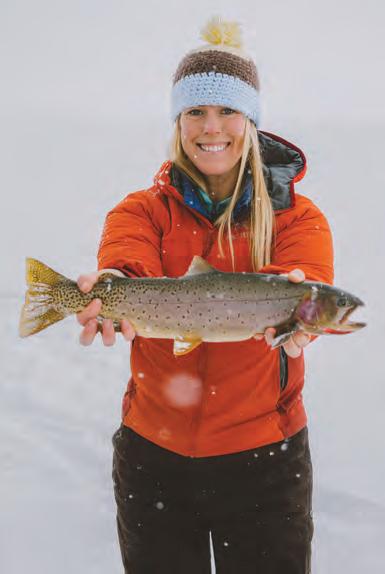

ENSURING SENIORS are engaged, supported, and thriving through nutrition services, wellness opportunities, enrichment programs, advocacy & assistance.
60 S. Main St, Driggs ID (208) 354-6973 swot@tetonseniors.com tetonseniors.org
Celebrate 25 Years of Teton Valley Magazine with a commemorative poster!

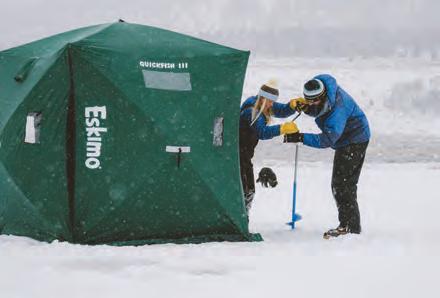
TOP Winter fishing can take a variety of forms. For this angler, it’s the fly-fishing variety on riverbanks. And with his furry companion.
ABOVE AND RIGHT For Anna Lindstedt and Nick Beatty, a few essentials for catching trout in the winter months include an ice auger, an ice shelter, and enthusiasm from the whole family.



Created by award-winning illustrator Alex Nabaum
Limited Edition 18-by-24-inch poster signed by the artist available online at tetonvalleymagazine.com or call 208.354.3466. $25 each.
Winter fishing requires a different knowledge base for understanding fish habits, feeding patterns, and behavior.
wear on top of these thin offerings.)
Winter fishing also requires a different knowledge base for understanding fish habits, feeding patterns, and behavior. “Water levels are low, so you have reduced habitat but not reduced [numbers of] fish,” Boots says. Trout metabolism also slows so they don’t need as much food, meaning you have to “envisage your forage differently,” he adds. He suggests using midges, although an egg pattern during early winter or streamers off tributaries in January or February are also great options. Mike Dawkins is partial to nymphing.
Both veteran anglers warn that in winter fishing you probably won’t land
as many fish as in the summer— but that that’s not the point anyway. It’s all about the adventure, with steam coming off the river and the sun shining bright over endless crystal white. You see the landscape in a new way.
Of course, you don’t need to stalk trout off icy riverbanks. You can always go ice fishing to satisfying the urge to drop a line.
Marcus Klebesadel, a longtime local angler, says he ice fishes five to seven days a week (yes, you read that right!).
“You have the chance to walk out on the lake and use a fish finder to see what the lakebed looks like and maybe even scout summer locations from ice fishing,” he says.
This is nothing like summer fishing, however
Marcus’s key advice to get started: “Use a spud bar [also called an ice chisel] to check your ice, and auger before
















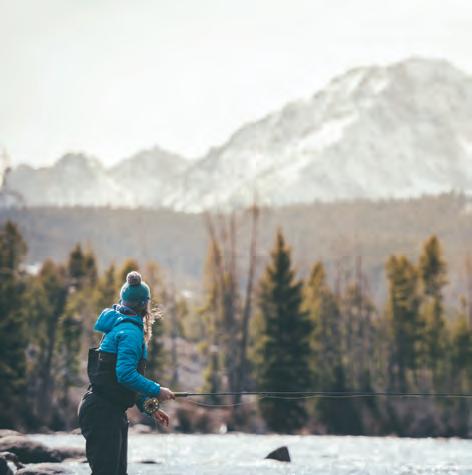

“The [once] private places are now getting over-crowded, but you can find more seclusion in the winter.”
Mike Dawkins, WorldCast Anglers
you even walk out there with a fishing pole. You also want to have a life vest.”


Ice fishing takes place on frozen lakes and there is definitely risk. Always seek expert advice before attempting it on your own and have a solid understanding of ice thickness guidelines. Ensure you have proper gear, as well, like winter clothes, an ice pick, and a throw rope in case the ice breaks. You must always auger holes to check depth and thickness before trusting the ice to support any weight. Weather is a key factor. Rapid warming or heavy wind can lead to ice breakup, potentially trapping you on the lake.
“With an electric auger you can drill probably five hundred holes in a day,” Marcus says. “Have a gameplan as to how much water you want to be over.”
When you think you have a good spot, make a hole and ideally use a fish finder. A minimum of four inches of clear, solid ice is required to support an average person’s weight. Check in with Idaho Fish and Game for tips and other needed safety requirements. “Once you’ve found your spot, set up your tent


nearby, drill a hole through the bottom, and you’re fishing,” Marcus says.
“I put foam tiles down in the tent and camp chairs, then a heater with a milk crate under it for air flow,” Marcus says. Once dialed, you can relax and fish in comfort. He suggests a first-time ice angler use something exotic to catch the attention of the fish. “No red devil spoons or jigging raps,” he says.

While their techniques and approaches may be different, all winter anglers share an appreciation for being on the water pursuing their next catch in more trying conditions. “It’s great to see the sunrise come up out there, to hear coyotes,” Marcus says.
Winter fly fishing seems to be growing the most rapidly, though. “It started in Colorado with their famous tailwaters,” Mike says. “They were such big ski destinations that people wanted a break from the hill.”
Locally, Boots says, sometimes half of the visitors in town might not be skiing on a particular day. It’s a perfect way for non-skiers to enjoy our endless backyard.



One thing’s for sure: the fish don’t go away when it gets cold. So, pull out your rod, gather your cold weather gear, and spend your next down day stalking the Teton region’s beautiful, finned residents. Check Conditions
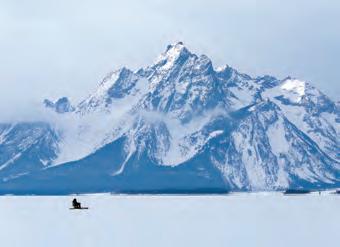






Backcountry Ambassador Program is in its third season, charged with sharing information and visiting with skiers and snowboarders embarking on a backcountry outing.

BY KRISTEN POPE PHOTOGRAPHY BY DAVID STUBBS
It’s just after sunrise on a blustery winter morning on Teton Pass. A foot of snow is in the forecast, and flakes are already flying as a line of commuters’ vehicles make their way from Teton Valley to Jackson Hole.
Another line of cars forms to the side—skiers and snowboarders eager to find some fresh powder. But first, they need to find a parking space. As they drink coffee and eat breakfast burritos, awaiting a space to open, a volunteer in a bright Teton Backcountry Alliance Volunteer jacket walks by, chatting about conditions and encouraging people to park tightly to squeeze in more cars. The volunteer is one of Teton Backcountry Alliance’s team of volunteer backcountry ambassadors, who are working to help things run smoothly—and safely—in the backcountry.
Teton Pass is a popular backcountry skiing and snowboarding access spot, and the highway running through it is the main artery connecting Teton Valley with Jackson Hole. Every day, thousands of commuters use the route to get to and from work, as well as to access shopping, medical services, and more. Avalanches have stormed onto the roadway a number of times in recent years, sometimes entrapping vehicles. In 2019, an avalanche brought several feet of debris down across the roadway during the morning commute, causing a closure that lasted until 5pm. Many speculated it was skier triggered.
Closures of Teton Pass Highway 22 occur during the winter because of slides and, in other cases, for avalanche mitigation control work. Complicating this work is the need to first clear the area of backcountry skiers and riders.
Conflict between backcountry users and commuters—as well as conflict among backcountry users over things like parking spaces—has led to backcountry users working together to find solutions.

TETON PASS IS KNOWN for its spectacular winter backcountry terrain that is also very accessible. The volunteer backcountry ambassadors are stationed at popular access spots like Teton Pass and Coal Creek to share information on conditions, ask about gear, and simply check in with backcountry users.
In 2017, the Teton Backcountry Alliance was launched “to promote public safety, community, stewardship, and sustainable access for Teton-area winter backcountry users,” according to the organization’s website.
“One of the main issues our little organization recognized as critical was continuing to maintain access to Teton Pass, with that potentially being imperiled as a consequence of a number of safety issues—the consequence of more and more people going to the pass and an increase in backcountry use,” says Gary Kofinas, chair of the Teton Backcountry Alliance steering
committee. “Teton Pass is spectacular winter backcountry terrain, some of the best in North America. And it’s very accessible, and so that combination draws a lot of people in.”
He says their initial concerns included parking lot congestion, dogs (see page 74 for tips on how to safely adventure with your pup), and people skiing treacherous routes on days with considerable (or higher) avalanche danger. “We worried that a slide could kill another skier or hit a car,” Gary says.
The Teton Backcountry Alliance held public meetings to raise awareness about these issues, and the idea for a volunteer program was born. The Teton Backcountry Alliance Volunteer Backcountry Ambassador Program is entering its third winter, and this year volunteers will be stationed at a number of locations, including the top of Teton Pass, Old Pass Road, Phillips Trailhead, Coal Creek, Stateline, and other sites located near popular access spots. Their work will complement that of Forest Service employees who currently work as pass ambassadors, including Jay Pistono, who has worked as a Teton Pass ambassador since 2005, first as a volunteer, then as a Forest Service employee. Mike Penterson, a Bridger-Teton National Forest winter snow ranger, runs the Jackson Ranger District’s snowmobile program and also works with the ambassador program.
The idea is for volunteers to be
boots on the ground and interact with others. “They’re not police, they can’t [issue] citations, they’re just there to chat with people and give information,” Gary says. “They don’t tell people where they should and shouldn’t ski, but they give people basic information.”
This is Natalee Stimpson’s third winter as a Backcountry Ambassador volunteer. She has skied all over the world, from Japan to India to Canada, and now lives in Driggs, where she spends her winters out on the slopes or volunteering when she’s not tending bar at local restaurant Warbirds. She has a Wilderness First Responder certification and has completed Avalanche 1 and 2 safety classes, as well as backcountry navigation and beacon training.
During a volunteer shift, she will chat with people, ask about their day, communicate info on conditions and observations, spread awareness, and help with crowd control on busy days. She’s helped people with gear failure safely descend, and

“Our biggest role up there is just talking with folks and promoting responsible recreation.”
Mike
DURING A TRAINING SESSION , the volunteers refreshed their snow safety understanding, practiced using rescue gear, and brushed up on their avalanche awareness
skills.
on Teton Pass during the spring of 2020, when COVID-19 closed ski resorts and national parks, and skiing on the pass became even more popular. He works to maintain infrastructure there, clearing snow from signage, delineating “no parking” zones with orange spray paint, making sure beacon checkers are functional, digging snow pits to assess conditions, and talking to people about everything from skiing safely to cleaning up after pets. “Our biggest role up there is just talking with folks and promoting responsible recreation,” Mike says.
Sometimes he’ll see people heading out unprepared, and he’ll try to encourage them to make good decisions. “We have seen folks going out there with absolutely no gear, and we want to try and catch those folks,” Mike says. “Ultimately, the decision is theirs whether they go or not, but really we’re just trying to let them know that one should have avalanche equipment, extra layers, food, water, first aid, and stuff like that.”
The ambassador program is growing, and a recent grant from the Jackson Hole Travel and Tourism Board will allow the alliance to hire a Backcountry Ambassador coordinator and purchase gear such as avalanche airbags and first-aid kits. Mike is quick to also point to the Wyoming Department of Transportation, highway patrol, sheriff ’s office, and search-andrescue organizations on both sides of the pass as instrumental partners in the effort.

she will talk to skiers and snowboarders about decisions and how they impact other recreationists and commuters below. Natalee will also venture out into the backcountry while volunteering because, she says, “talking to people when we’re out in the backcountry is a lot more effective than [doing so when] standing in the parking lot.”
As part of his role as winter snow ranger, Mike Penterson began working
Natalee says the ambassadors have been well received. “We didn’t really know in the beginning how we were going to be perceived by the community, and it’s just been a lot of ‘Thank yous,’ and a lot of ‘It’s really great to know you’re here,’” she says. “To foster that harmonious existence is really important and is also recognized by the community, which is a good feeling.”
To learn more or to get involved in the ambassador program, visit: tetonbackcountryalliance.org/tetonpass-access.



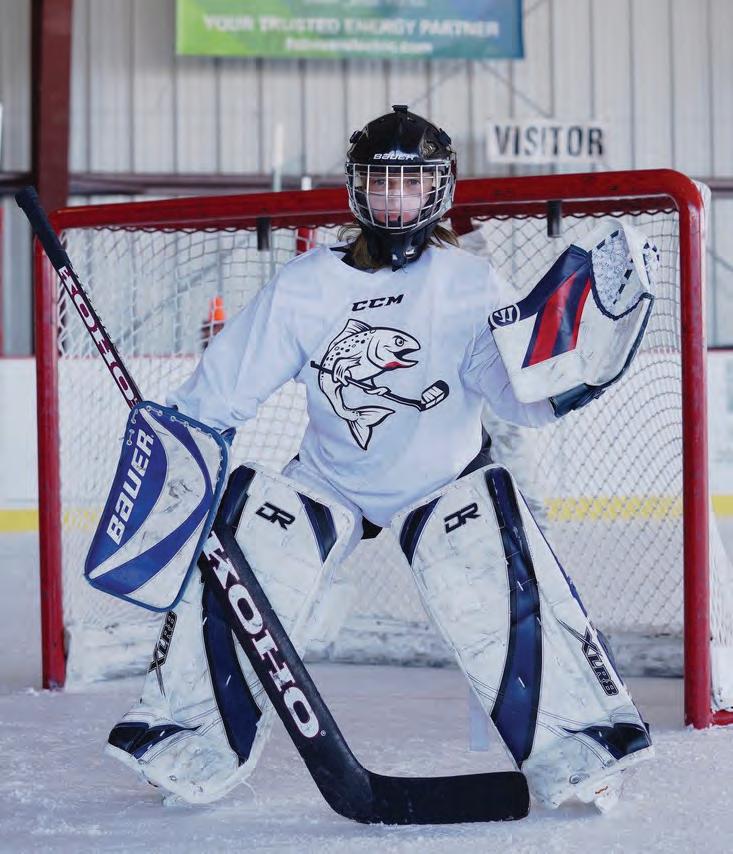


These












BY JEANNE ANDERSON
I’ve always appreciated the personal connections we make while traveling. When traveling, we’re exposed to other cultures on an individual scale by seeking out experiences and connection with other people, places, and ways of life.
The idea of sister cities formalizes this value on a broader scale: creating cultural links from one town to another.
Called “twin towns” or “friendship partnerships” in some places, sister cities often share similarities like geography, population, challenges, goals, or even festivals. Or they might connect via history, religion, or even the name of the towns. What they all share is an intentional connection to promote tourism, education, and cultural integration between the two.
I’d encountered sister cities before but it’s only in the past few months that I’ve realized so many municipalities of the world are so deeply connected, interpersonally and by legal agreements. Some connections seem logical: Boise, Idaho, for instance, has a long history of Basque immigration, and thus it’s unsurprising that one of Boise’s sister cities is Gernika, in the heart of Basque country in Catalonia, Spain. On the other hand, Boise’s connections to its other sister cities (yes, a place can have multiple!), Bengkulu, Indonesia, and Chita, Zabaykalsky Krai, Russia, are more obscure. Arcane interconnections are every bit as fascinating.
Sometimes a well-known individual generates the connection between two places. The sister city to Jackson,
Wyoming, is Lienz, Austria. These towns share mountainous geography, tourismbased economies, and a single famous resident—Olympic gold-medal skier Pepi Steigler, who helped bring Lienz, the place of his birth and rise to skiing fame, and Jackson, where he helped build the fame of the resort, together in 1971. Another Jackson sister city is Tlaxcala, Mexico, linked to the region as the origin city of many residents.
In Teton Valley, staff at the City of Driggs has been discussing the possibility of establishing a sister city relationship. Driggs is currently considering seeking public input regarding a possible sister city proposal and about what kind of place might be suitable as a national or international partner. At press time, the city was not sure on the timeline.
Mayor August Christensen has fielded suggestions of possible twin towns. An initial suggestion was Briançon, France. Briançon has an established relationship with Teton Valley. Members of Grand Targhee Resort’s ski patrol have participated in seasonlong professional patrol exchanges with members of the French resort in Briançon, Serre Chevalier. The French visitors shared houses locally and made many friends here. The Targhee patrollers enjoyed the same abroad.
THE CONCEPT OF SISTER CITIES started in 1942 when the mayor of bombed-out Coventr y, England, sent a telegram to officials in Stalingrad (no w Volgograd), Russia. After the Ba ttle of Stalingrad, some 830 women in Coventr y donated six pence each to their Russian “sisters.” All of them wrote their names on a tablecloth given to Stalingrad in 1947, embroidered with the phrase “A little help is better than big sympa thy.”
HOW MANY SISTER CITIES IS TOO MANY? Check out the signposts for Plovdiv, Bulgaria (population 350,000, with twenty-two sister cities), and Los Angeles (popula tion 4 million, with twenty-five sister cities).
CLEVER SISTER CITY MATCHUPS:
• Toledo, Ohio, and Toledo, Spain
• Paris, France, and Paris, Texas
• And, for pure wit, nothing measures up to Dull, Scotland, and Boring, Oregon!
IDAHO’S SISTER STATES ARE:
• Jalisco, Mexico
• Shanxi Province and Taiwan Province, China
• ChungCheongBuk-do Province, South Korea

Another suggestion as a sister city for Driggs is Wanaka, New Zealand, a town of similar size and agricultural background. Mayor Christensen visited there in 2005 and notes that, although they raise sheep there, not cattle, she remembers that the community-oriented feel of the town would be familiar to anyone from Driggs. Also, Wanaka, like Driggs, is located near two large national parks and is next door to two ski resorts.
On the surface, that sounds like a good fit. And other places that have become second homes for some local residents, in Mexico and Costa Rica, for instance, have emerged as prospects. Many sister city proposals look good on paper. But what makes some more meaningful, productive, and enjoyed by their co-citizenry than others?
Broad-based community involvement provides the best foundation for success, according to Sister Cities International. This national nonprofit matches up towns and serves as an umbrella organization to encourage programming and outreach.
Sometimes a single person, city agency, or group has been the driving

The sister city relationship between Idaho Falls and Tokai-Mura, Japan, is a model worth studying. It has lasted for forty-one years, and is still going strong.
The match is grounded in two unmistakable similarities between the two towns— (sweet) potatoes are grown in the area around
force to a sister city initiative. The more inclusive and realistic a town is about what will work for them, the more likely the twinning will be long-lasting.
Mayor Christensen is keeping an open mind; if there are more cultural differences than likenesses, she points out, residents may encounter and absorb more, than if the two places seem like mirror images of each other
She also notes that the process of finding a partner locale should not reflect the preferences of a single individual. “I’d like to do a very broad survey, completely open-ended, and see what we get,” she says.
As with any burgeoning relationship, it’s pretty clear there’s no one formula for choosing the right partner Creating a relationship with a sister city, like any friendship, requires time and engagement, curiosity, and perhaps a certain magic. Whether or not you have wanderlust in your blood, Mayor Christensen hopes you’ll participate in the city’s outreach. Public involvement will be key, she says. Then, maybe we can all go pay our new sisters and brothers a visit.

Falls / Tokai-Mura, Japan
Tokai, and it’s a primary location for nuclear research in Japan, drawing a similar comparison to our famous spuds and Idaho National Laboratory.
Centered on a robust annual exchange, except during COVID-19, both cities send and host a group of visitors. When grownups from Idaho Falls go to Tokai, youngsters between the ages of 12 and 17 come to Idaho Falls. It’s reversed the next year.
And it’s affordable: the groups stay with host families, so the cost to travelers is air fare and personal incidentals. Any citizen can go, not just public officials.
The rest of the year, the two Idaho Falls age groups meet regularly to sustain their
interest and to learn the nuances of Japanese etiquette, like how to bow and properly present a gift. Although students age out of the youth group after high school, at least some have continued membership in the adult group, according to Kendra Peck, president of the Idaho Falls Sister City Youth Group.
Anyone in Idaho Falls, however, can enjoy a Japanese experience without ever leaving Eastern Idaho at the volunteer-built and -maintained Friendship Garden and Japanese Pavilion.
Located on a rocky island in the Snake River near Key Bank on Broadway, the Friendship Garden was created to celebrate the thirtieth anniversary of the towns’ sister-cityhood. It features a large ceremonial stone lantern given previously to Idaho Falls by Tokai-Mura (the town’s official name means “Tokai Village”).
Then, in 2016, after a couple of years of preliminary work, again by volunteers (many of whom had visited Tokai on exchanges), the Japanese Pavilion was added, with donated funding from Tokai for ornamental tiles.
The sister-city groups, garden, and exchange take effort and commitment to sustain. Cindy Ozaki, who serves as president of the Idaho Falls Sister City Adult Group, attributes the longevity of the relationship to the long-standing friendships made between individuals within the two towns.
“It has been so successful because we’ve maintained contact and there’s a lot of continuity with the members through the years,” she says.
After the devastating earthquake and tsunami in 2011 in Japan, the sister city groups in Idaho Falls teamed up with Rotary International to raise funds to purchase solar batteries so Tokai would have backup systems in an emergency. They are used at schools and libraries when no crisis is present.
Cind y wholeheartedly believes in the value of a town having a sister city: sharing lessons about culture, school administrations, even sanitation and recycling efforts. She has visited Tokai on eight different exchanges, accompanying two of the student groups.
“Tokai is like my second hometown,” she says. “My friendships there are as meaningful as those here.”
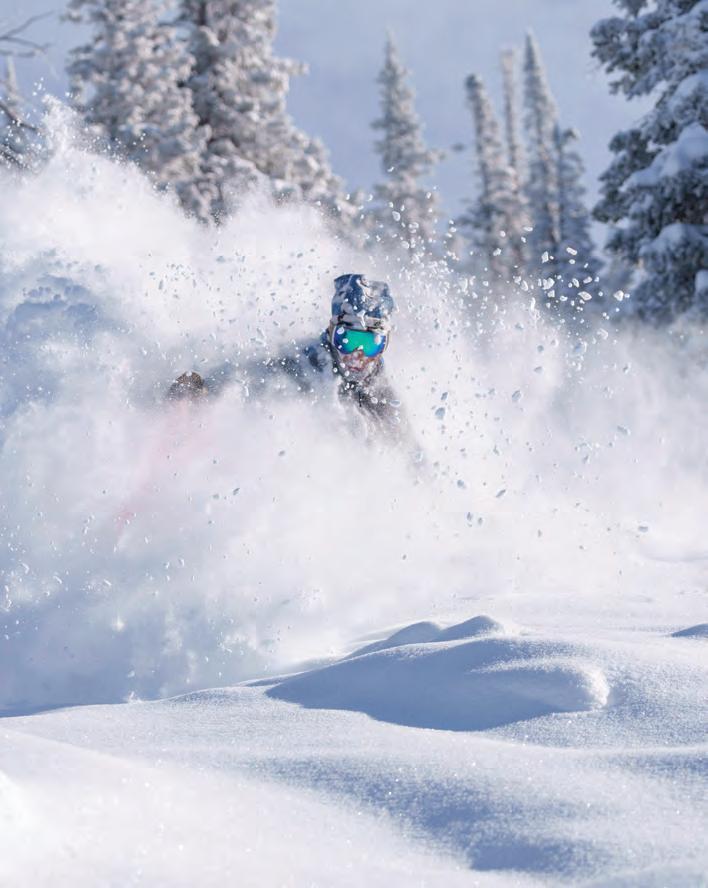







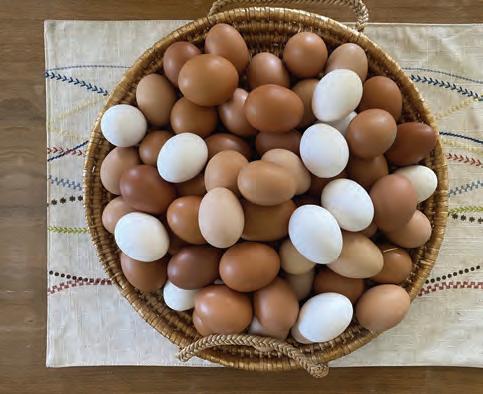






Stock up on farm-fresh produce even as the snow flies


TETON VALLEY ONLINE FARMERS MARKET allows residents to stock up on fresh produce and delicious goods during the winter months when farm-fresh food is a little harder to come by. It also helps support our hard working farmers and makers.


BY KATE HULL


Come
October, the valley bids adieu to the homegrown goodness for sale on the Driggs City Center Plaza, as the farmers market comes to an end. But not for long!
Thanks to the efforts of local food purveyor Rob Dupré—the man behind the delicious meads, pestos, and hummus at Chasing Paradise—farmers market fans can get their fix of sustainable produce all winter long. Cheese, baked goods, and more are available to purchase all winter and spring long as part of the Teton Valley Online Farmers Market.
“I started an indoor winter farmers market in 2020, but we had to shut it down with the onset of COVID-19,” Rob says. “The online market is a way that we can safely distribute food from local farmers and producers to the community.”
The website is stocked with ideas for delicious food and goods from a who’s who of some of the valley’s wellloved local farms and other purveyors of sustenance. Fresh produce from Canewater Farm; salad mix, carrots, and potatoes from Cosmic Apple Gardens; goat milk and cheeses from Endless Winter Farm; pastured beef and pork from Late Bloomer Ranch; jams from Dusty Hound Farm; and pesto, hot sauce, “All Good” bars, cider, and meads from Chasing Paradise—the shopping list goes on and on.
Online ordering is available each week from 8am Sunday to 6pm Tuesday. After ordering, customers then pick up their goods Thursday afternoons at the Chasing Paradise Meadery in Driggs. With help from Winter Winds Farm cheesemaker Lacey McNeff, the online market is providing one more way for

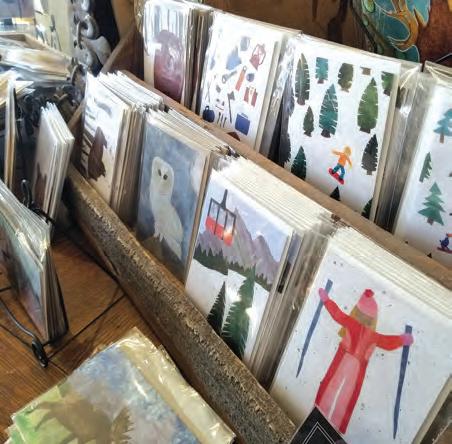













ORDERS ARE PLACED ONLINE from 8am Sunday to 6pm Tuesday. Then, customers pick up their goods Thursday afternoons at the Chasing Paradise Meadery in Driggs.
“Hopefully, this will become a sustainable and convenient way to buy from local farmers and producers.”
Rob Dupré,
Chasing Paradise
Teton Valley residents to enjoy fresh, local produce, meats, cheeses, and other packaged foods throughout the year— while also supporting local farmers beyond the summer market season.
“Hopefully, this will become a sustainable way for consumers to buy from all their favorite local farmers and producers with the convenience of being able to pick up everything in one location,” Rob says. “We also hope that it encourages farmers to produce more by creating an outlet for their goods before and after the outdoor market season.”
There might not be anything much better than a Cosmic Apple Gardens potato, roasted to perfection and topped with a slather of Rob’s pesto or of other goodies you can order up. Find out more at tvfm.local foodmarketplace.com.


mountainacademy.org

310 North Main Street
Driggs, ID 83422
208-354-2003
Open Daily 11am–10pm
From the owners of El Abuelito in Jackson comes Agave, Teton Valley’s very own family Mexican restaurant! Serving fajitas, burritos, and all of your Mexican favorites, cooked to perfection seven days a week, with lunch specials from 11am to 3pm daily. Bienvenidos amigos, mi casa es su casa! [p. 38]

36 South Main Street
Driggs, ID 83422
208-354-2307
Open Daily 8am–7pm barrelsandbins.market
Teton Valley’s source for all-natural and organic products including local and organic produce, meats, cheeses, and bulk food; 460 Bread baked fresh daily; beer and wine; nutritional supplements; health and beauty products; all-natural pet foods; and much more! Juice & Smoothie Bar is open 9:30am to 1:30pm daily. Check in for sandwiches and salads, as well as other grab-and-go takeout options. [p. 37]

Broulim’s Food and Pharmacy
240 South Main Street Driggs, ID 83422
208-354-2350
Open Mon–Sat 7am–11pm broulims.com/driggs
Order sandwiches to go made from your choice of Columbus meats and cheeses. Breakfast sandwiches and paninis made fresh daily. Our deli has hot baked or rotisserie chicken, take-and-bake pizza, and other meals to go. Check out our display of hand-cut specialty cheeses! Freshly prepared salads, our own Sushi Bar, and hot Asian food. Daily specials of smoked meats available. Inquire at the deli for catering services. New coffee bar. [p. 43]

57 South Main Street
Victor, ID 83455
208-399-2872
Visit website for menus, hours, and online ordering butterinvictor.com
Life is better with butter, that is the true belief of husband-and-wife team Marcos Hernandez and Amelia Hatchard. Stop in or order your to-go online for a delightful spin on brunch classics, such as al pastor hash, biscuits with poblano sausage gravy, or our Mexican grilled cheese. Whether you are craving tacos at 8am or eggs at 2pm, we are here for all your brunch needs. Follow our Instagram @butterinvictor for specials and updates. [p. 49]

Citizen 33 Brewery & Restaurant
364 N Main St, Driggs, ID 83422
208-354-2073
Open Daily 4pm - 9pm citizen33.com
From the team behind Forage Bistro and Tatanka Tavern, Citizen 33 Brewery & Restaurant in Driggs is dedicated to serving fresh, delicious, and locally sourced food and beer from the Main Street pub. Enjoy ever-changing brews on tap by Brew Master Nick Farney and a delicious menu by Chef John Perry featuring elevated bar bites like local fried cheese curds and fried pickle chips, burgers, and flavorful entrees. Citizen 33 was built for the community and visitors of Teton Valley to come together and celebrate this amazing place with delicious food and cold craft beer. Cheers to the citizens, “a native or inhabitant,” of Route 33! [p. 30]

Forage Bistro & Lounge
285 Little Avenue, Suite A Driggs, ID 83422
208-354-2858
Open Daily 4pm – 9pm
Reservations Recommended forageandlounge.com
Forage Bistro, specializing in seasonal regional cuisine with an emphasis on local ingredients, offers creative, chef-inspired dinner seven days a week. Enjoy half-priced bottles of wine every Wednesday. Amazing burgers, steak, trout, market fish, pasta, homemade desserts, and more made from scratch. Our open kitchen with nothing to hide offers diners a unique experience in Teton Valley. [p. 30]

Grand Targhee Resort
Alta, WY 83414
800-TARGHEE (827-4433) grandtarghee.com
This winter come check out the brand-new Powder Cache Bar & Grill. When you join us for a meal, you’ll see why Powder Cache is one of the best-kept secrets in Teton Valley. Our warm, welcoming atmosphere and excellent service allow you to sit back, relax, and take in the incredible views from our floor to ceiling windows or get toasty next to our beautiful stone fireplace. Our culinary team offers fresh, local, and sustainable ingredients to create our American West-inspired mountain comfort dishes. At the Trap Bar and Grill, enjoy a wide selection of local microbrews on tap, great food like the famous Wydaho Nachos, and HD TVs with your favorite sports teams! Snorkels is your slopeside bistro; enjoy a cup of hot coffee or cappuccino with a Wyoming-style breakfast burrito. Return in the afternoon for homemade soups and sandwiches. [BC]

430 Old Jackson Highway Victor, ID 83455
888-899-1656
grandtetonbrewing.com
Grand Teton Brewing has a wide selection of beer made right here in Teton Valley. Come enjoy a pint on the expansive lawn or grab a six pack to go! Visit our website for up-to-date hours and information. [p. 54]

Linn Canyon Ranch
1300 East 6000 South
Victor, ID 83455
208-787-LINN (5466) linncanyonranch.com
Join us for a winter wonderland dining experience! We’ll greet you at the lodge with warm drinks before we board the horse-drawn sleigh for a tour of the ranch. Upon your return, you’ll enjoy cocktails and hors d’oeuvres before being seated at your private table in the historic lodge. Experience the fine hospitality and elevated dining the Linn family is known for. Advanced reservations are required. For holiday and private parties, please call to inquire. [p. 93]
Refuge Taphouse
2 North Main Street
Victor, ID 83455
Sun–Thurs 3pm–9pm; Fri–Sat 2pm–10pm @refuge_taphouse
Stop by Refuge Taphouse on Main Street in Victor for craft beer and wine by the glass. Enjoy twelve constantly rotating taps from top-tier local, regional, and international craft breweries and cideries. Take happy hour home with an eclectic selection of to-go beer and wine. Ages twenty-one and over. Menu features light bar snacks, and outside food is welcome. Refuge Taphouse is the place for aprés ski.[p. 92]

Rise Coffee House
40 Depot Street Driggs, ID 83422
208-354-RISE
Open Thursday- Tuesday 7:30am–2pm CLOSED WEDNESDAYS risedriggs.com
Rise Coffee House is a place where our community gathers and connects with one another. If you are looking for a beautifully crafted espresso drink, breakfast, or mouth-watering baked good, you’ll be sure to find it here. Come enjoy culture, community, and excellent coffee. Voted best coffee in Teton Valley four years in a row. Cheers!

Pinky G’s Pizzeria
37 S. Main Street Victor, ID 83455
208-787-PINK (7465)
Open Daily, 12pm - 9pm
Delivery, 5-9pm in Victor City Limits order at pinkygs.com
Pinky G’s is bringing a taste of the Big Apple to Wyoming, Montana, and now Victor, Idaho. Founded by Tom Fay in Jackson Hole in 2011, Pinky G’s rocketed to fame a year later, when Guy Fieri shot an episode of “Diners, Drive-Ins, and Dives” there and was blown away by their hand-tossed New York-style pizzas. Stop by the new downtown Victor location for take-out. Delivery within the Victor city limits. Enjoy house-made dough and marinara made from scratch daily, with pizzas like the Abe Froman, topped with spicy Italian sausage, buffalo mozzarella, fresh chopped basil, and a balsamic drizzle; or try Guy’s Pie invented by Guy Fieri himself. [p. 45]

Pizzeria Alpino
165 North Main Street Driggs, ID 83422
208-354-8829
Open for dinner. pizzeriaalpino.com
Pizzeria Alpino is proud to offer Teton Valley fresh and delicious Italian inspired Rocky Mountain fare, perfect for any day. We are grateful to showcase locally grown products, including Morning Dew Mushrooms, Crowfoot Ranch, and Late Bloomer Ranch. Please come join us!

Tatanka Tavern
18 North Main Street, 3rd Floor of the Colter Building, Suite 315 Driggs, ID 83422
208-980-7320
Open Daily 4pm–9pm tatankatavern.com
Tatanka Tavern offers wood-fired artisan pizza, salads, and the finest of craft beers and wines. Bring in the family for a night out or grab a seat at the bar and watch the game. Enjoy local favorites like the Fungus Amongus for dinner daily. [p. 30]

Teton Thai
18 North Main Street
Driggs, ID 83422
208-787-THAI (8424)
Lunch Mon–Fri 11:30am–2:30pm; Dinner Daily 4pm–9pm tetonthai.com
Voted Teton Valley’s favorite restaurant, Teton Thai offers something for everyone. Enjoy a variety of our family’s favorite recipes like our homemade crispy egg rolls, coconut milk curries, or savory wok seared noodles. Stop by our taproom located down the hall from Teton Thai. Serving old-world beers along with a menu from Teton Tiger, our sister restaurant located in Jackson, Wyoming. Dine in or take out. [p. 22]

The Royal Wolf
63 Depot Street Driggs, ID 83422
208-354-8365
Open Daily; serving lunch and dinner 11am–late theroyalwolf.com
Since 1997, locals and visitors alike have enjoyed discovering this off-Main Street establishment offering a diverse menu of sandwiches, burgers, salads, appetizers, and entrées served in a casual, smoke-free, pub-style environment. Complementing our menu is a full bar serving all your favorite beverages, including cocktails, wine, and a selection of regional microbrews on draft. Enjoy outdoor dining on our spacious deck during the summer. Daily food and beer specials, WiFi, and billiards. Stop by to meet old friends and make new ones. Snow sagas and fish tales told nightly. (Hours and menu subject to change.)

15 South Main Street
Driggs, ID 83422
208-354-9463
Daily happy hours 4pm–6pm
threepeaksdinnertable.com
threepeakscatering.com
Enjoy classic Italian dishes with a wild western flare: Elk Meatballs, Spicy Pork Sausage Lasagna, and Idaho Rainbow Trout, just to name a few. A great downtown Driggs restaurant close to the stoplight. Boutique wine selection available for takeout or on-site enjoyment. Plenty of gluten-free and vegetarian options. Private inhome or on-site catering and cooking classes available. We feature locally made artwork in our unique, circa 1940s building. Visit our website or call for reservations. [p. 32]

45 North Main Street
Victor, ID 83455
208-787-2221
Open seven days a week
Over one million served! For more than sixty-five years, the Victor Emporium Old Fashioned Soda Fountain has served delicious milkshakes, including the World Famous Huckleberry Shake. Gourmet coffee and espresso served daily. The Emporium is also a great place to pick up those unusual gifts. Where the locals meet before enjoying the great outdoors here in Teton Valley. [p. 24]

Victor Valley Market
5 South Main Street
Victor, ID 83455
208-787-2230
Open Daily 7am
Victor Valley Market is your local grocer and the place to get fresh seafood and choice meats in Teton Valley. Offering a unique selection of groceries, from organic and specialty items to your everyday needs, including a full selection of wine and beer. Our gourmet deli counter offers delicious house-made takeout dishes, along with sandwiches made with locally baked bread, fresh salads, housemade soups, and so much more! Victor Valley Market has all that you need to make a delicious meal, whether for eating in or picnicking out. [p. 10]

Located at Teton Valley Resort
1208 Highway 31
Victor, ID 83455
208-821-1982
Open Daily wanderlustbistro.com
Make Wanderlust Bistro & General Store your go-to spot for tastes of the world. Stocked with fun treats and serving up delicious takes on Mexican favorites each weekend. Stop in the next time you are craving travel from the safety and beauty of the Tetons. Stay up to date on hours, special events, and new products by following us on Instagram @wanderlustbistro. [p. 49]

Wildlife Brewing
145 South Main Street
Victor, ID 83455
208-787-2623
Open Wed-Sun, 4pm–9pm wildlifebrewing.com
Since 2003, Wildlife Brewing has been a cornerstone of Victor’s restaurant scene. Locals and visitors alike visit daily to enjoy awardwinning microbrews and freshly made hand-tossed pizza. With a large family-friendly seating area and a unique stainless-steel bar, Wildlife is the perfect place to enjoy a quick brew after a fun-filled day, or bring the whole family to enjoy the best pizza in the valley. Come on in and ‘Live the Wildlife!’ [p. 25]
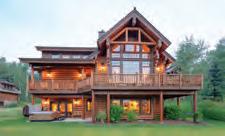
C & C HomeServices
57 South Main Street
Victor, ID 83455
307-201-1861 cchsjacksonhole.com
C&C HomeServices provides luxury vacation rentals as well as vacation rental representation and premium home management services to homeowners in Jackson Hole and Teton Valley. We stand by uncompromising standards designed to overachieve the expectations of our owners and guests alike. Homeowners and rental guests enjoy meticulous attention to detail and twenty-fourhour service. We offer services, including short-term rental management, long-term rental management, caretaking, housekeeping services, snow removal, and lawncare. It is our pleasure to care for our clients’ homes and provide our guests the best in comfort and convenience. [p. 7]

3300 Ski Hill Road Alta, WY 83414
800-TARGHEE [827-4433] grandtarghee.com
After a day on the mountain, it’s time to relax with the family in one of a variety of western-style slopeside accommodations. Be ready for first chair as you relax in the high alpine setting with a quaint mountain village that offers dining and shopping. Rooms vary in size and budget, from sleeping four to ten guests. The Sioux Two Bedrooms offer a small kitchenette and are perfect for your next resort getaway. The resort is dog friendly and offers pet friendly rooms. Call 800-TAR-GHEE to book your stay. [BC]

Linn Canyon Ranch
1300 East 6000 South Victor, ID 83455
208-787-LINN [5466] linncanyonranch.com
Experience our authentic timber-frame cabin nestled in the snowy foothills of the Tetons, where quiet luxury awaits. While you’re here, take a ride on a horse-drawn sleigh, and join us for an evening of elegant Western dining in our historic lodge. [p. 93]

18 North Main Street #105
Driggs, ID 83422
800-746-5518
mail@tetonhomestead.com tetonhomestead.com
You’ve known Grand Valley Lodging for more than thirty years as the premier property management company in Teton Valley. Now, under new local ownership, we are ready to turn things upside down. Introducing Teton Homestead—It’s time to reset your expectations of what to expect in a property management company. Vacation homes, long-term rentals, caretaking, and housekeeping. Teton Homestead—Expect more. [p. 12]
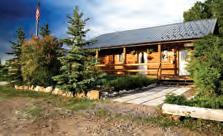
Teton Valley Cabins
34 East Ski Hill Road
Driggs, ID 83422
208-354-8153 or 866-687-1522
stay@tetonvalleycabins.com tetonvalleycabins.com
Nestled amongst mature cottonwoods, Teton Valley Cabins welcomes you for your special getaway, vacation home base, or family or group reunion. Quaint charm, rustic cabins, and affordable rates await you at Teton Valley Cabins, just one mile from Driggs, with its restaurants and shops. Enjoy our picnic and activity grounds or explore Teton Valley from here. We are centrally located, with Grand Targhee Resort just up the road and other recreational opportunities within a few minutes’ drive. Various room types are available. Our rooms are equipped with a microwave, fridge, satellite TV, and WiFi. [p. 10]

Teton Valley Property Management
253 South Main Street
Driggs, ID 83422
208-354-3431
info@tetonvalleypm.com tetonvalleyvacationrentals.com
Allow us to find that perfect home or condo to make your vacation memorable. All our homes are nicely furnished, meticulously maintained, and fully equipped to accommodate your group at a fraction of what you would pay for hotel rooms. All homes come complete with linens, kitchen necessities, smart TVs or satellite TV service, high-speed internet, soaps, and paper products. Book online and receive all the conveniences of home, away from home. [p. 8]

The Teton Valley Music Alliance (TVMA) connects the community with our amazing local musicians, artists, and music instructors, as well as the venues to catch acts live.
Stay in tune and follow us for the upcoming musical events in the valley and to connect with our musicians!

The Cadillacs
Teton Valley is home to three meetinghouses of The Church of Jesus Christ of Latter-day Saints. Visitors of all ages and backgrounds are welcome.
Sunday worship services are held in Victor (87 East Center Street; 9am, 10:30am, and 12pm), Driggs (225 North 1st Street; 9am, 10:30am, and 12pm), and Tetonia (209 South Main Street; 9am and 10:30am).
Worship services are centered on the partaking of the bread and water of the sacrament. This one-hour meeting includes congregational hymns, prayers, and brief sermons focused on the love of God and atoning sacrifice of Jesus Christ. Following this meeting, visitors of all ages are invited to attend a one-hour Sunday School class, divided by various age groups. Additional information can be found by calling Zane Calderwood (208-317-3325), Wade Treasure (208-351-4480), or by visiting ChurchOfJesusChrist.org
2301 North Highway 33 | Driggs, ID | 208-220-0351 grandviewbaptist.org
As an Independent Baptist Church, we believe in traditional hymns and use only the King James Bible for all services and Bible studies. Join us Sunday mornings at 10am for Sunday School followed by a service from Pastor Daniel McDonald at 11am. A children’s program is available during service times. We also offer a Thursday night (7pm) prayer meeting, Saturday night (7pm) men’s prayers, and a Sunday evening (5pm) service. Visit our website to learn more about our Christian Homeschool Co-op, Kids’ Club (fall and winter), and Vacation Bible School Camp (summer). We provide transportation to all services with our van route ministry, just call for a pickup. Come join us in God’s Word and make the world a better place!
St. Francis of the Tetons Episcopal Church
20 Alta School Road | Alta, WY 83414 | 307-353-8100 sftetons@silverstar.com | stfrancis.episcopalidaho.org
Join us for Sunday morning worship beginning at 10am. St. Francis of the Tetons Episcopal Church welcomes worshippers of all walks of faith. In the shadow of the Tetons, this historic church offers an opportunity to experience God’s presence and join in fellowship, spiritual renewal, and service to others.
265 North 2nd East | Driggs, ID | 208-354-8523 tetonvalleybiblechurch.org
Teton Valley Bible Church exists to glorify God and exalt Jesus Christ as Lord through Holy Spirit-empowered living and worship. Our mission is to make disciples through gospel-centered outreach, the spiritual building-up of believers, and living in loving fellowship with one another. We gather together to worship the Lord on Sunday mornings; please visit the website for service times. Pastor Jim Otto (MDiv) is committed to expositional preaching and Biblical theology. Childcare is available and all are welcome. [p. 92]
Grades: Preschool–12 | 307-733-1313
mountainacademy.org
At Mountain Academy of Teton Science Schools learning is in our nature. We are a National Association of Independent Schools (NAIS) accredited independent day school serving students preschool through 12th grade. We are one program of Teton Science Schools, which also includes a field education program for schools and visitors from around the world, educator professional development, and a graduate program. [p. 105]
District Office: 208-228-5923
tsd401.org
Empowering our students to reach their full potential—Teton School District 401 provides a safe and exceptional learning environment where career and college readiness are the academic cornerstones of a relevant and progressive education. [p. 49]
Grades 9–12 | 208-228-5924
tsd401.org
Teton High School strives to recognize the uniqueness of the individual in preparing for a lifetime of learning. THS provides a safe and academically focused learning environment, where students are challenged for career and college readiness.
Grades 9–12 | 208-228-5928
tsd401.org
Basin High School is an alternative for students who meet the state criteria for enrollment. Students obtain credits through a stateapproved independent-study format, with assistance from certified staff.
Grades 6–8 | 208-228-5925
tsd401.org
The mission of TMS is to be a safe and innovative organization that empowers each student and staff member to develop a foundation of self-efficacy, build relationships, overcome challenges, stretch their grit and resilience, and recognize their potential.
Grades 4–5 | Driggs 208-228-5926
tsd401.org
Rendezvous’ mission is to create a caring community of learners who inspire each other to embrace curiosity, value others’ opinions, and develop a foundation of self-efficacy.
Victor 208-228-5929 | Driggs 208-228-5927 | Tetonia 208-228-5930
tsd401.org
The mission of the TSD 401 elementary schools is to be integral in the partnership between school, home, and community in nurturing and encouraging all children to become productive citizens and lifelong learners.










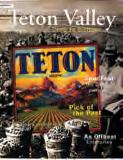














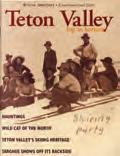



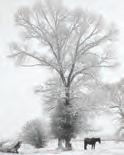








































This winter you'll have 600 acres of awesome new terrain to explore. The Colter Lift delivers avenues of fun, varying runs, like the steep pitches of Silver Jae, the rollers of Rolling Thunder, and the trees of Tanglefoot. Come spread out on the mountain and find your new favorite run.

